
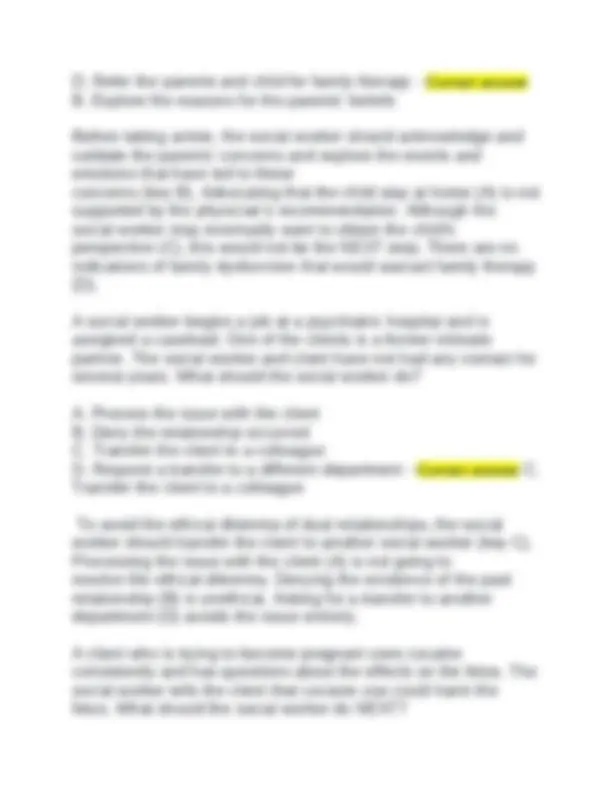
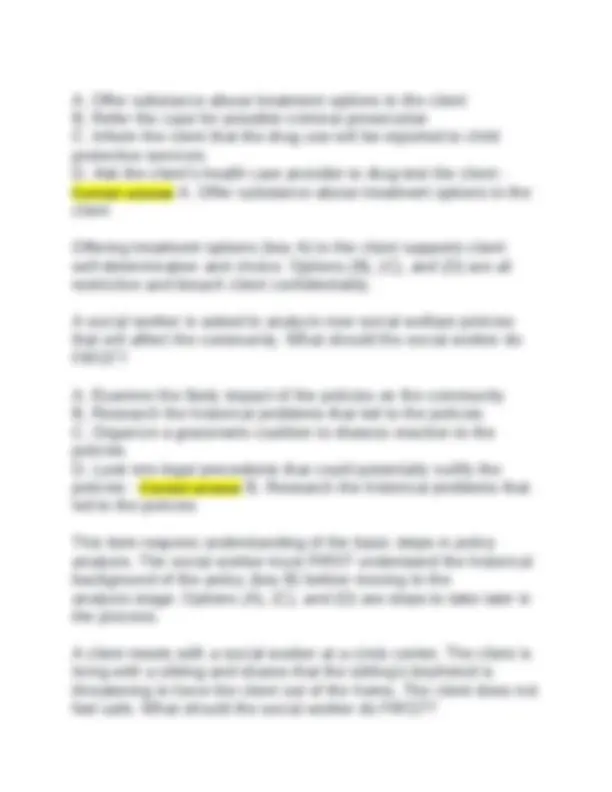
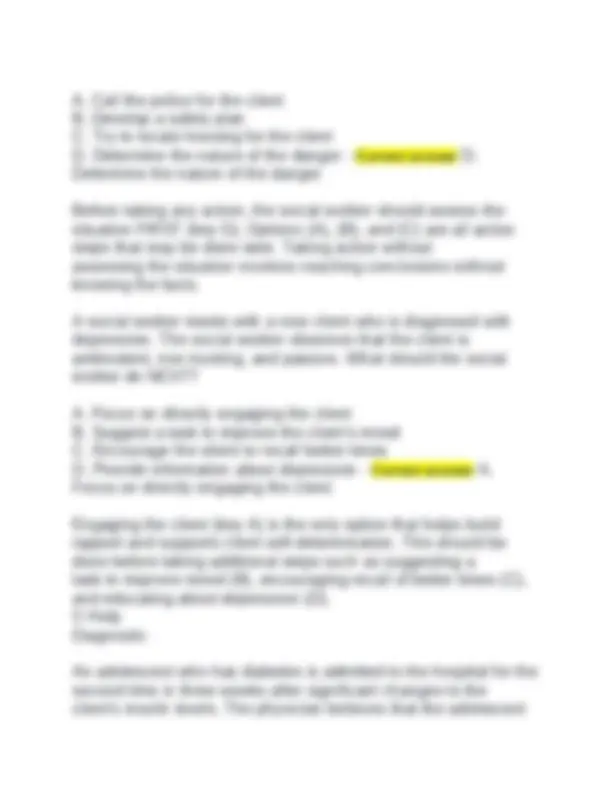
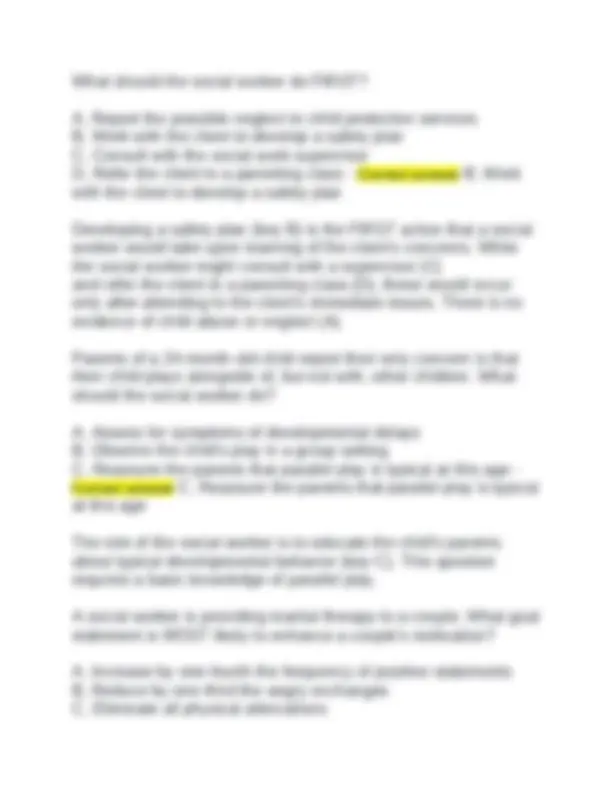
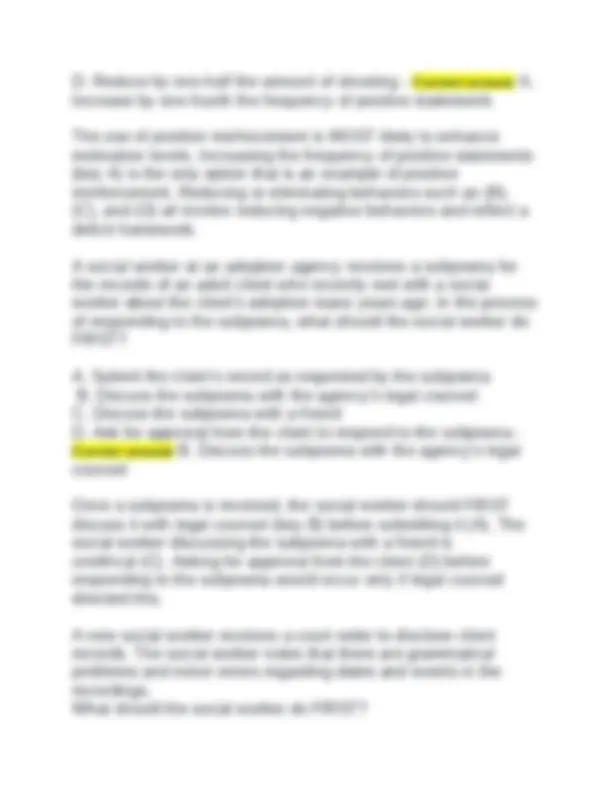
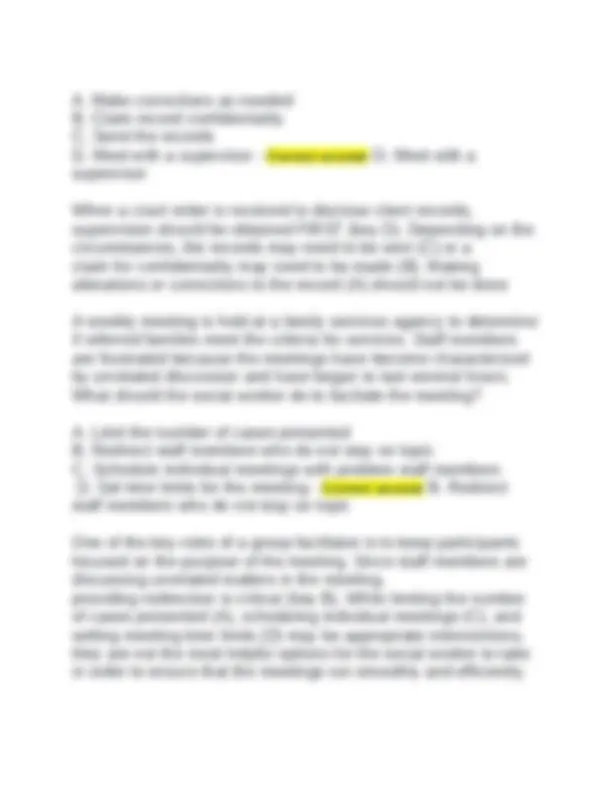
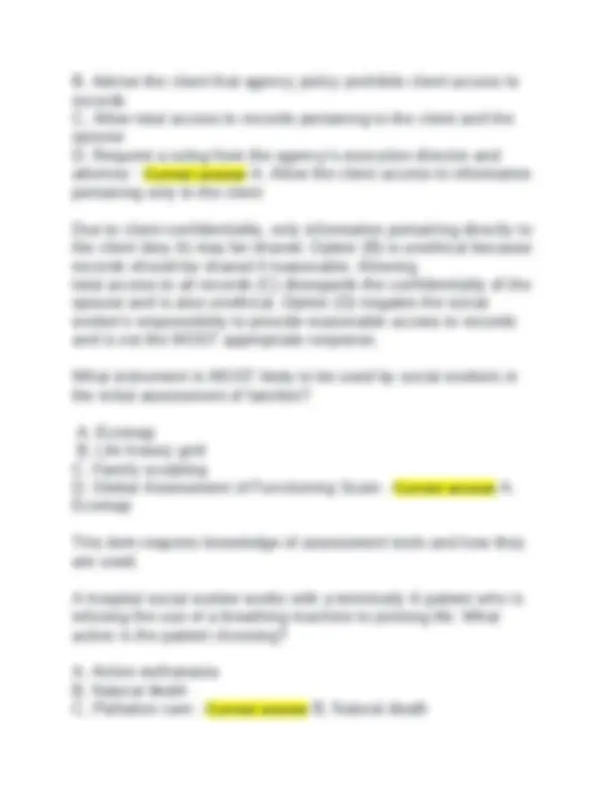
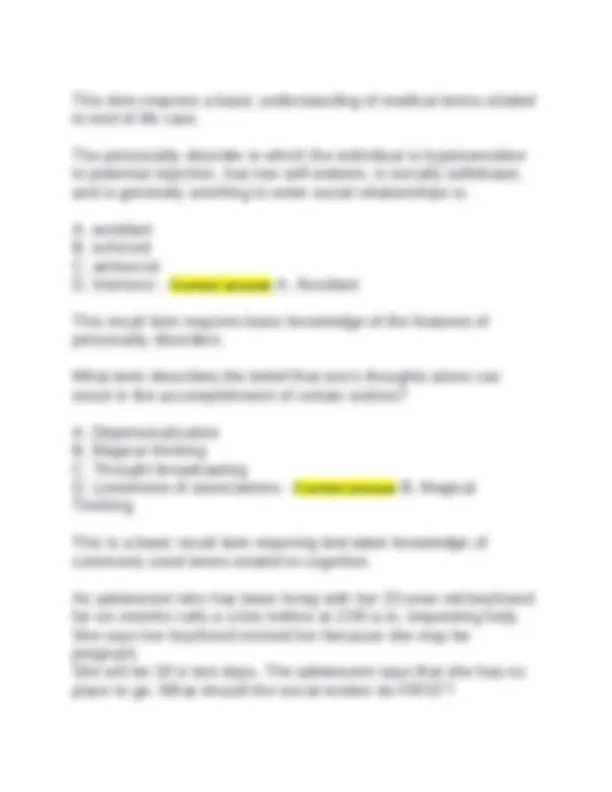
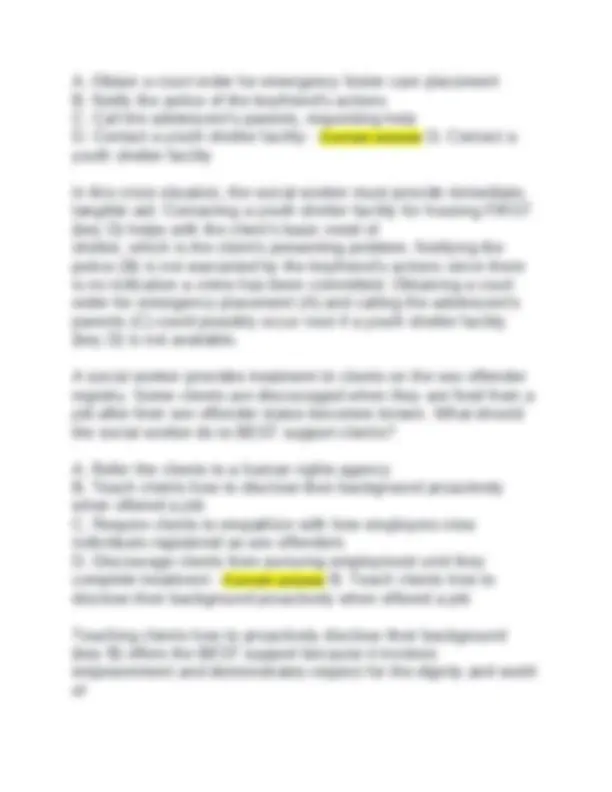
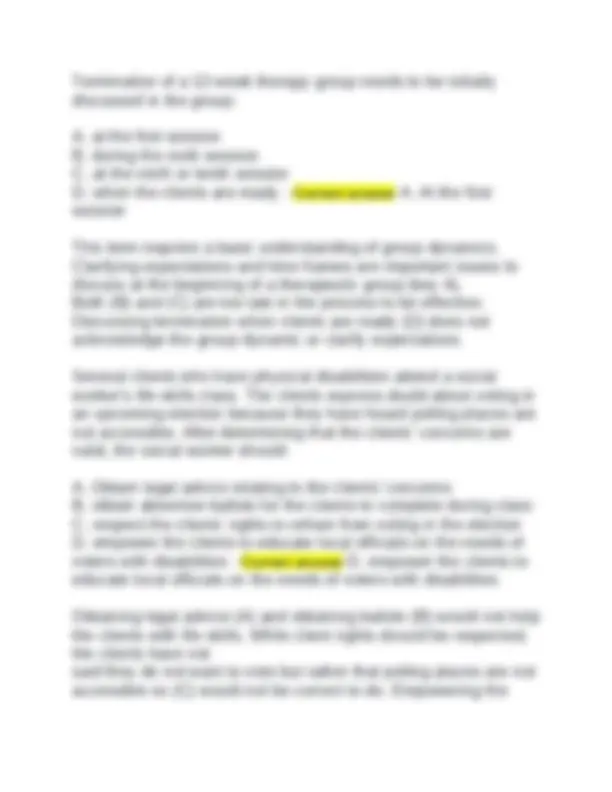
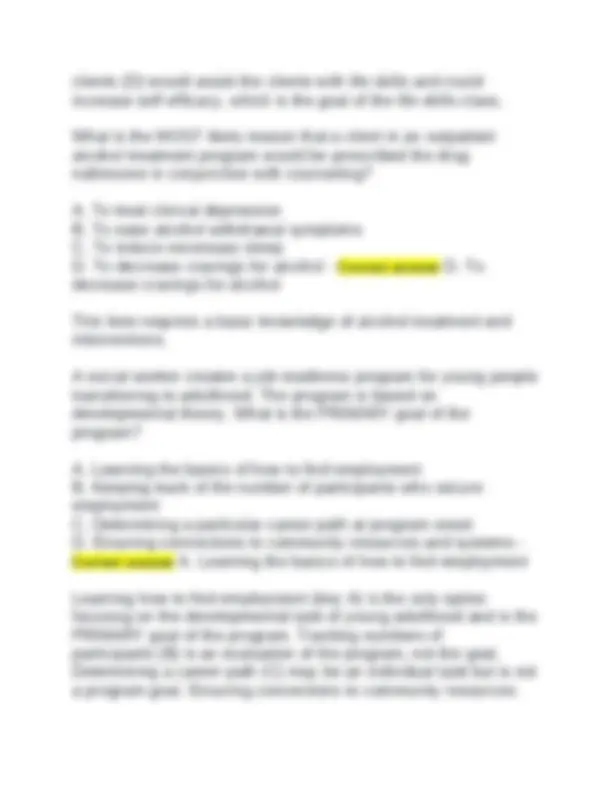
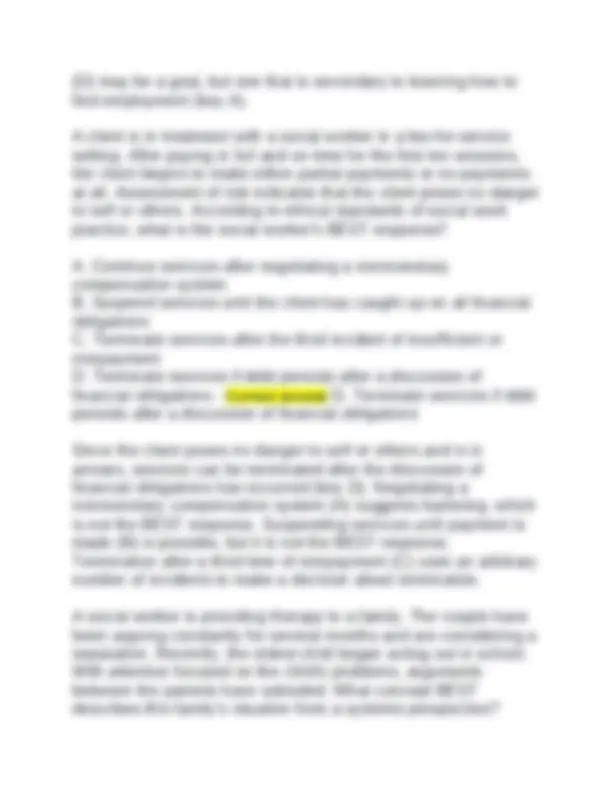
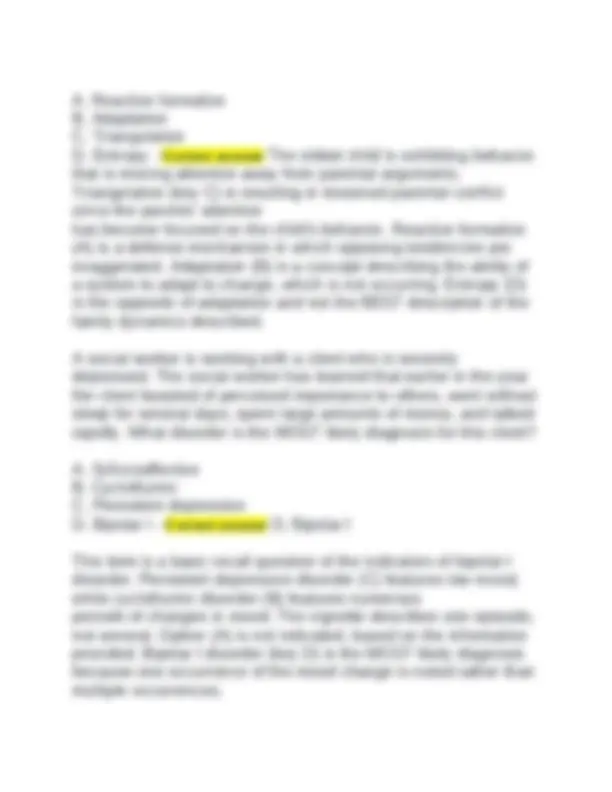
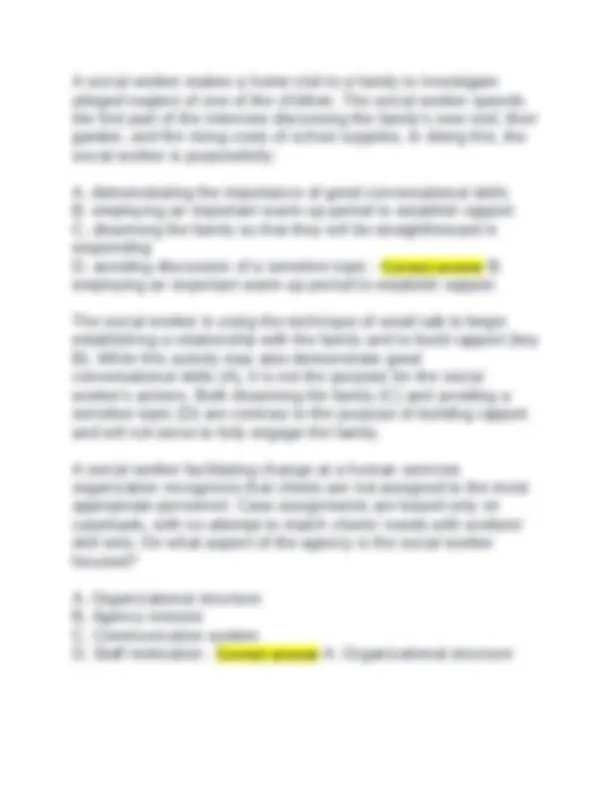
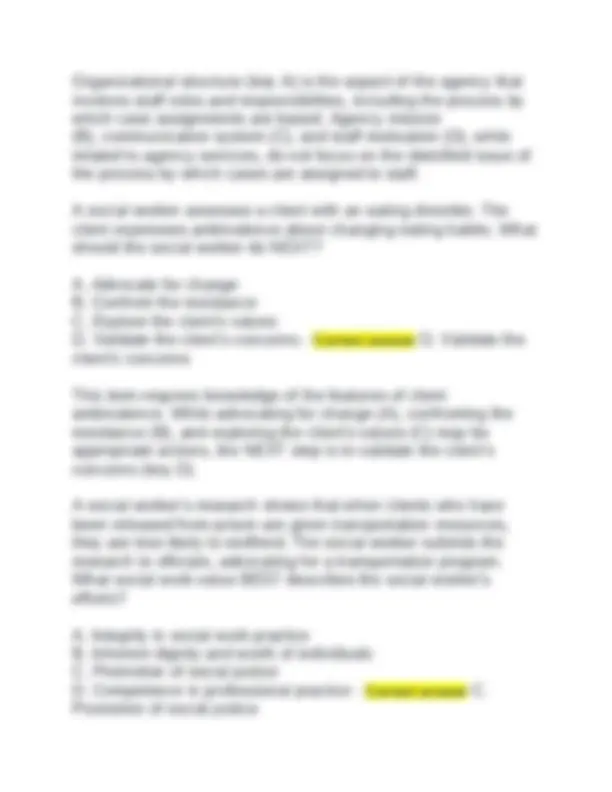
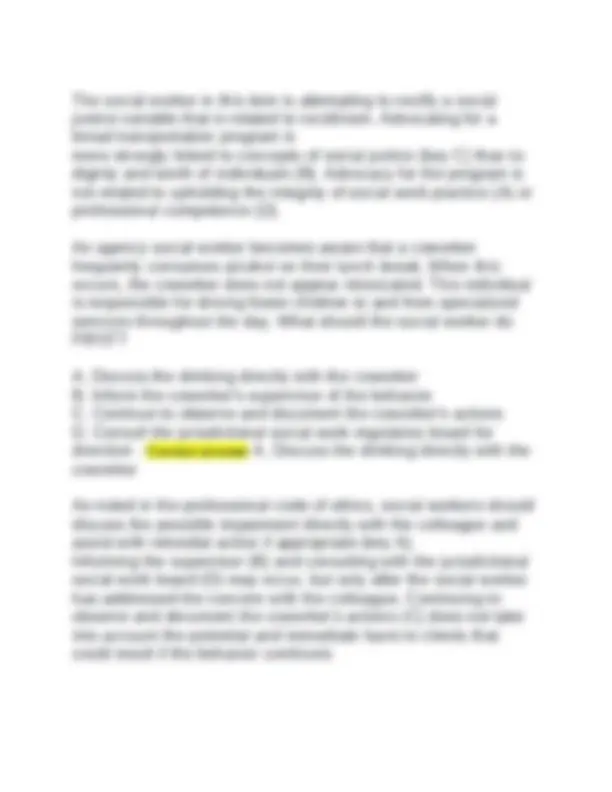
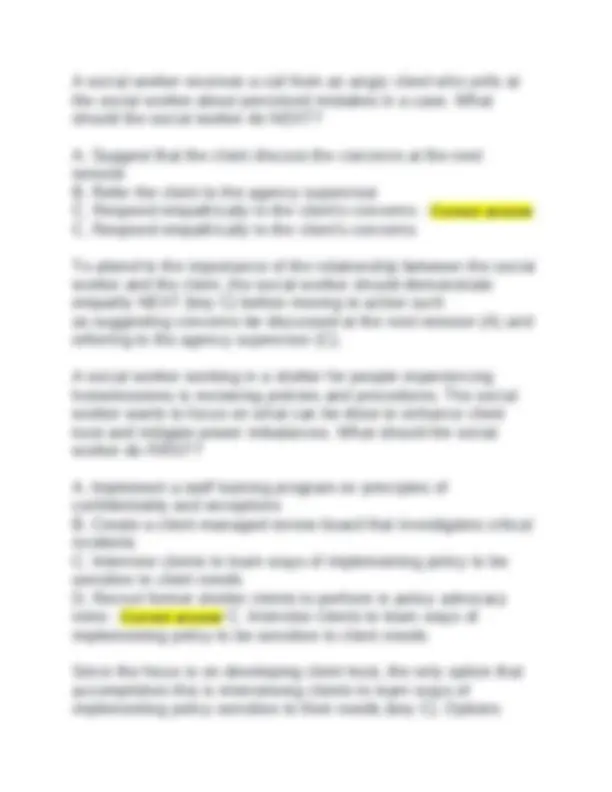
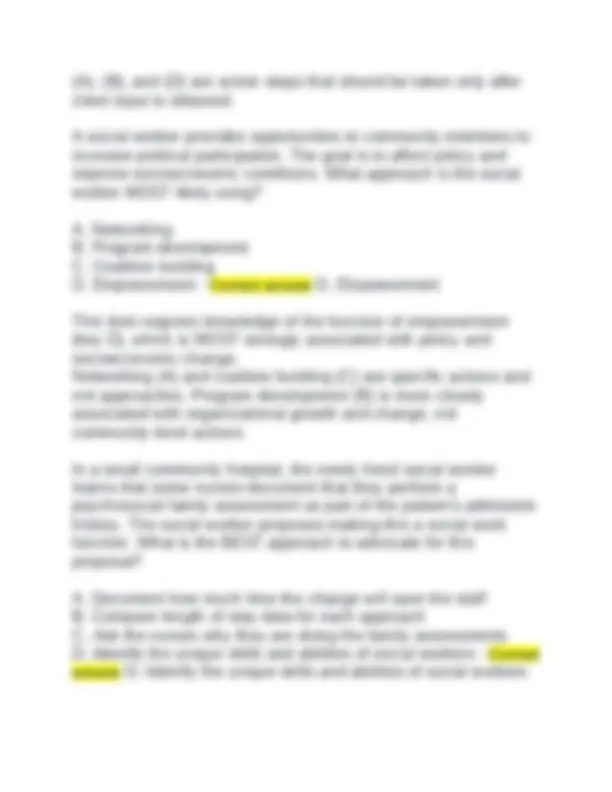
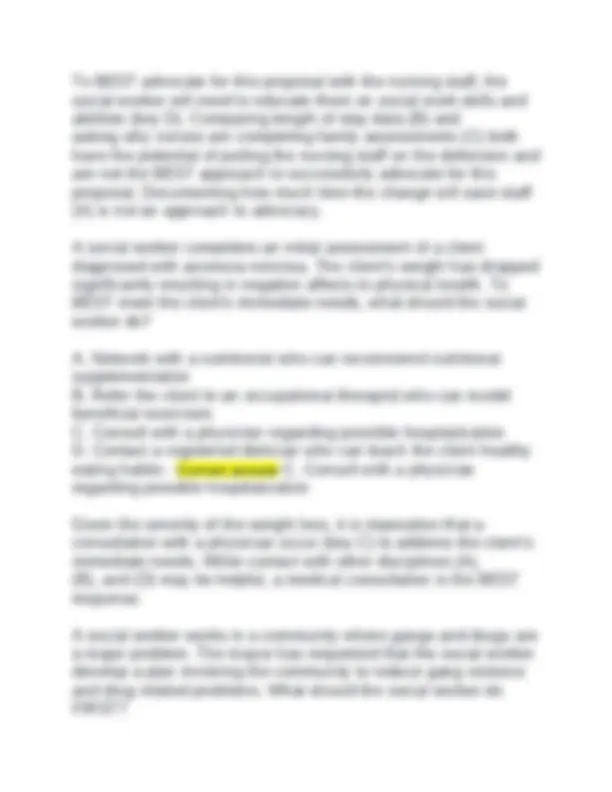
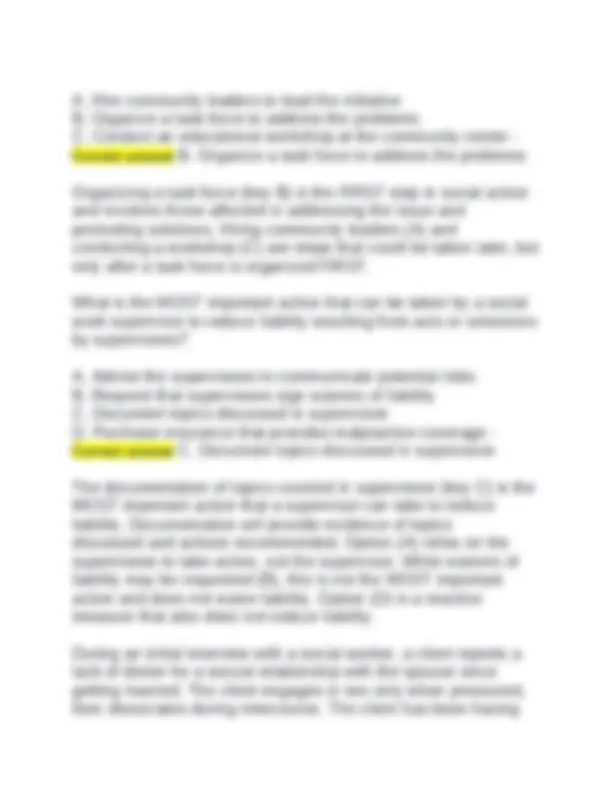
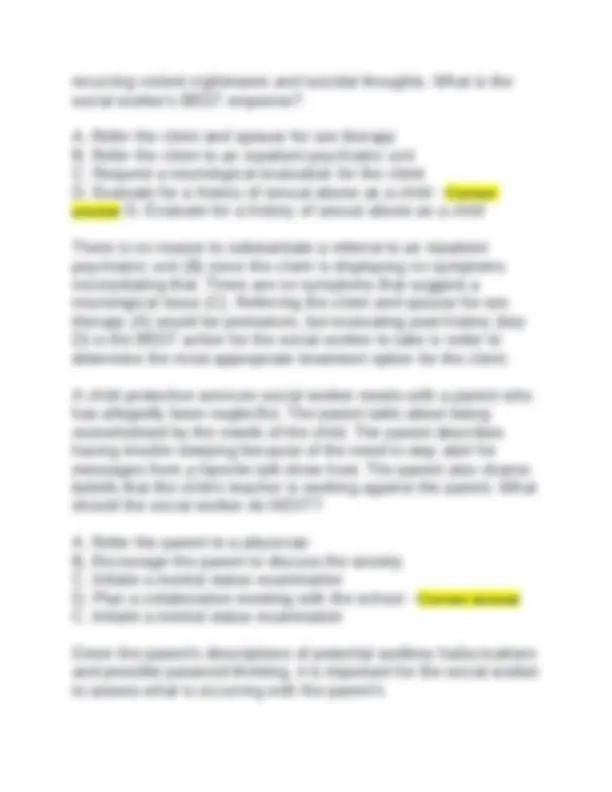
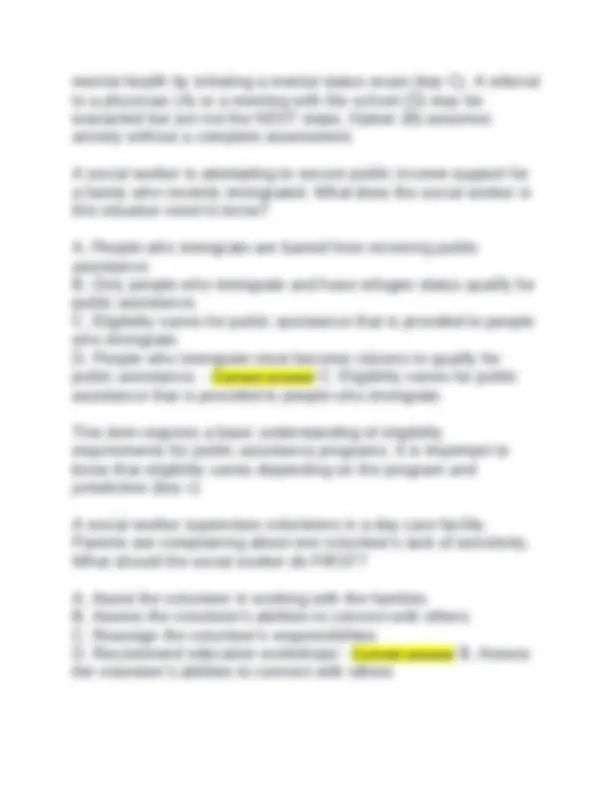
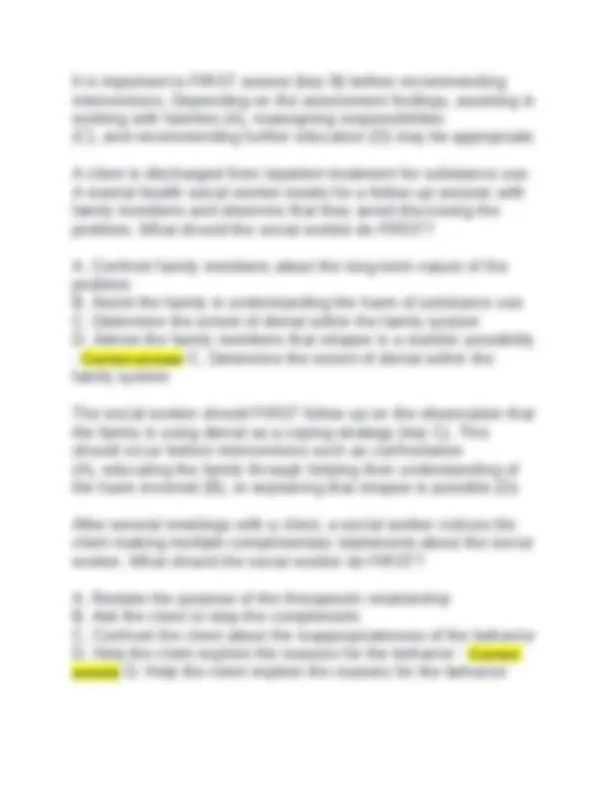
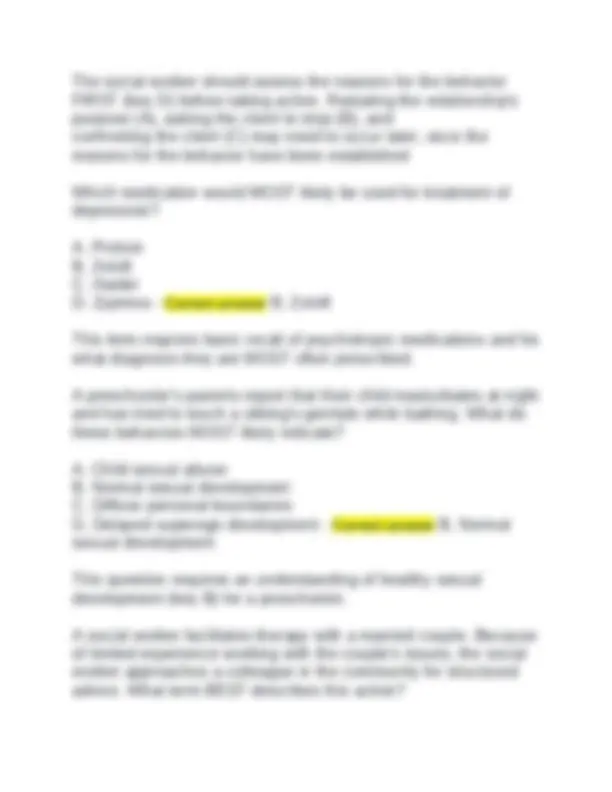
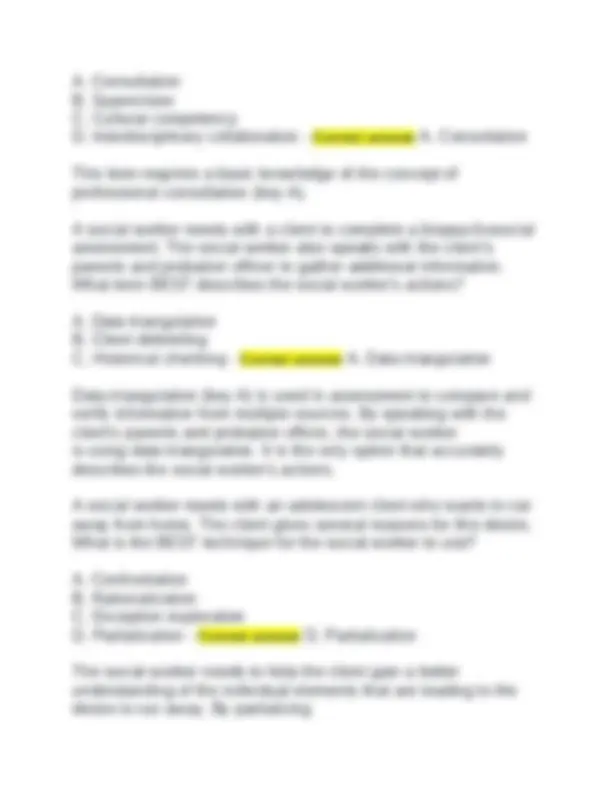
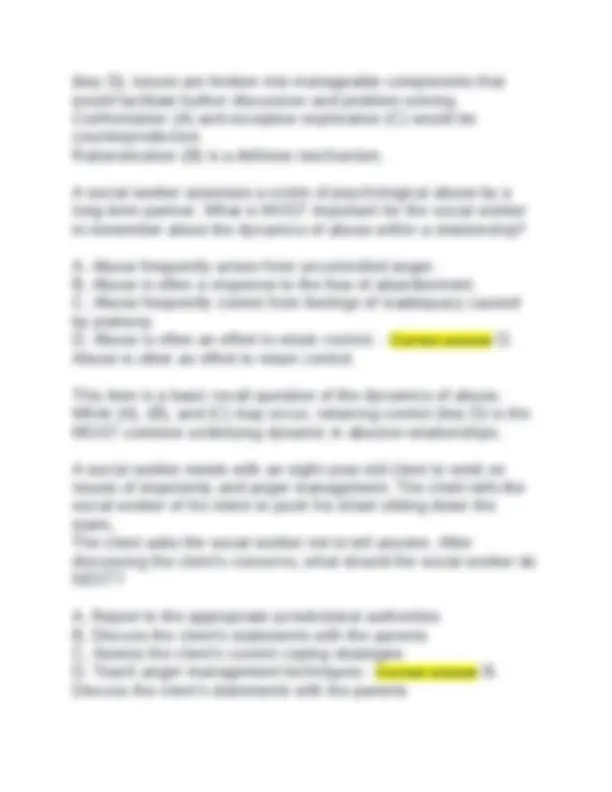
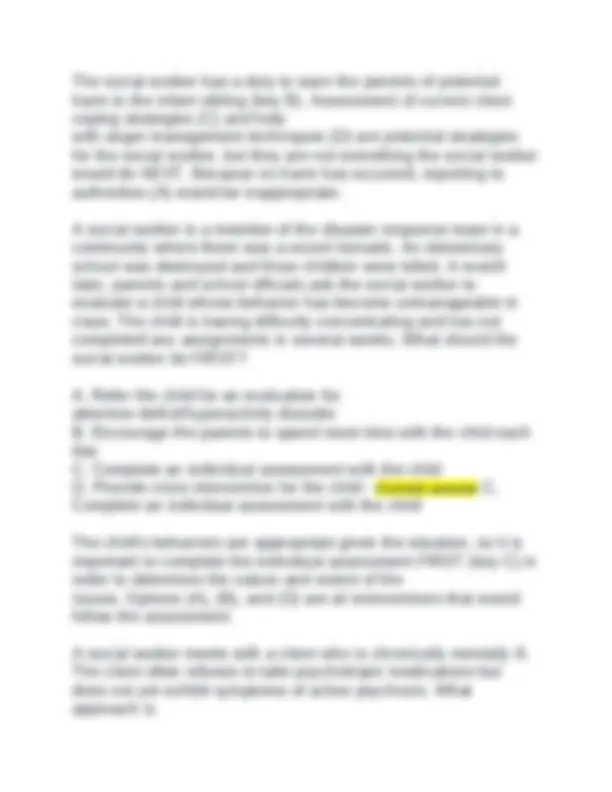
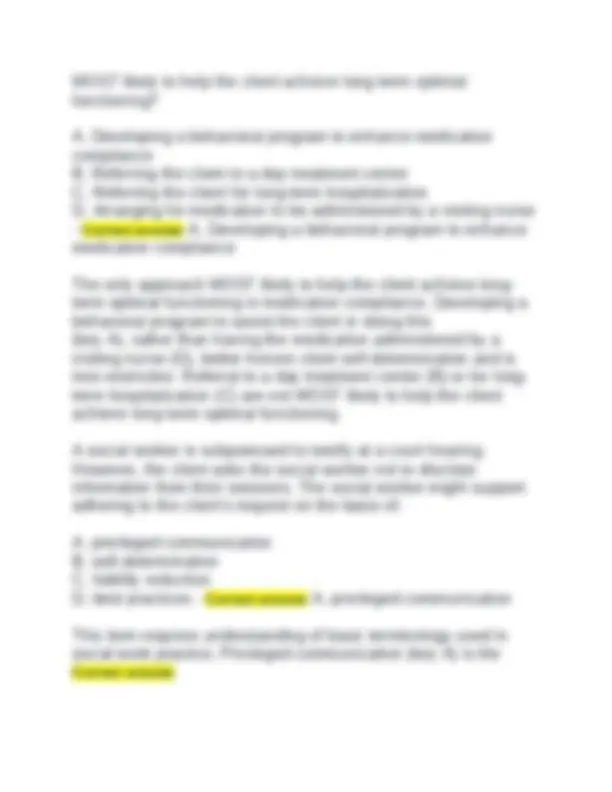
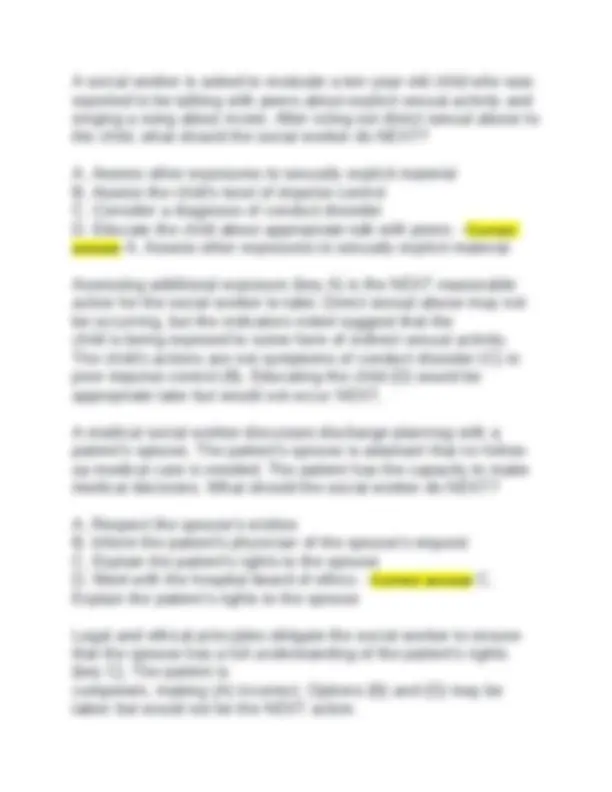
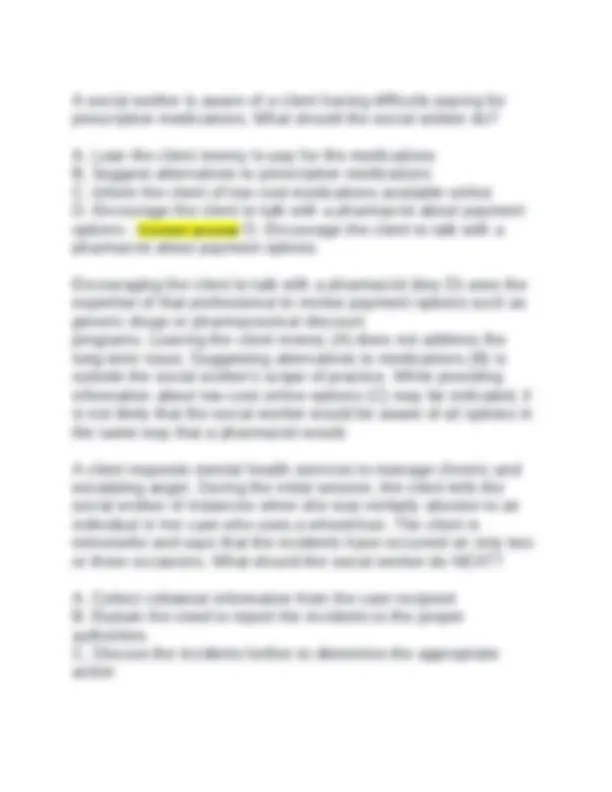
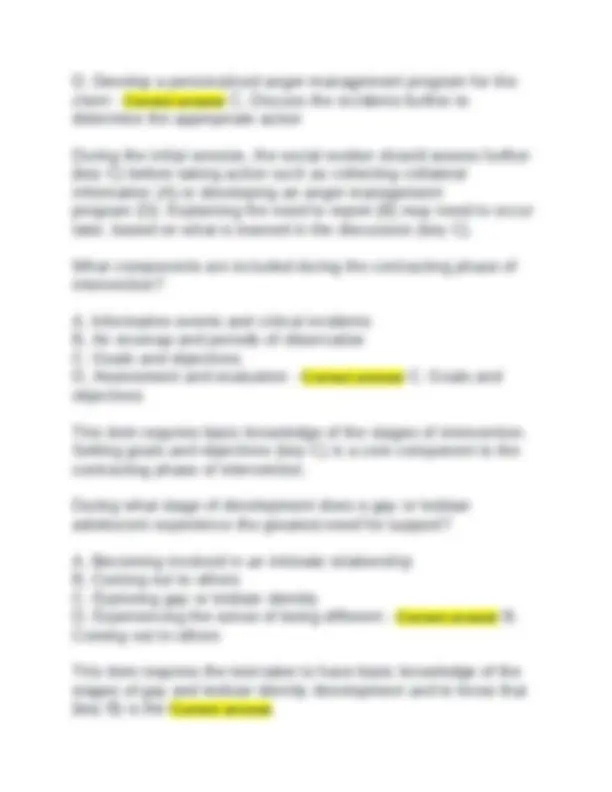
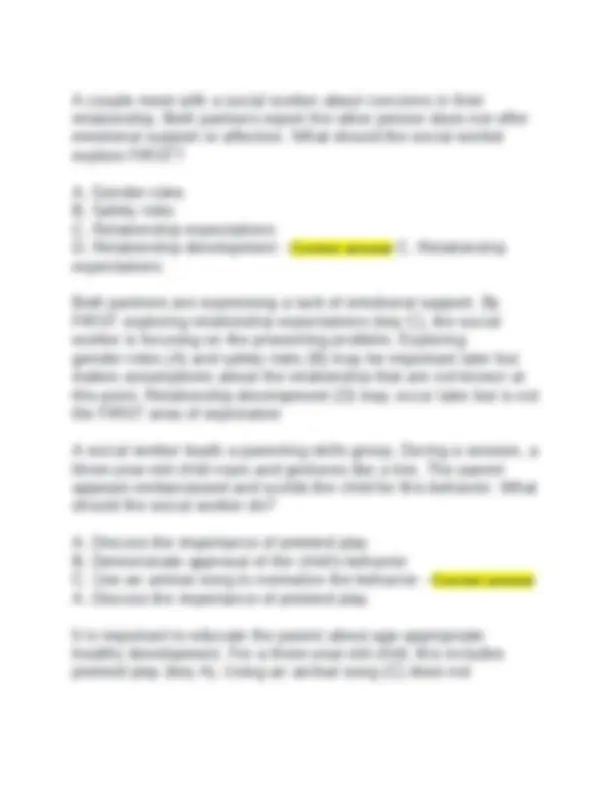
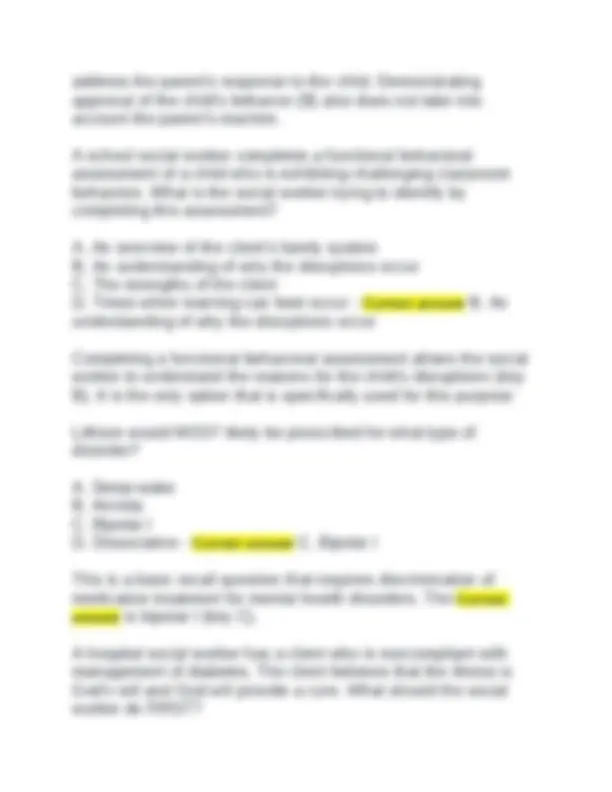
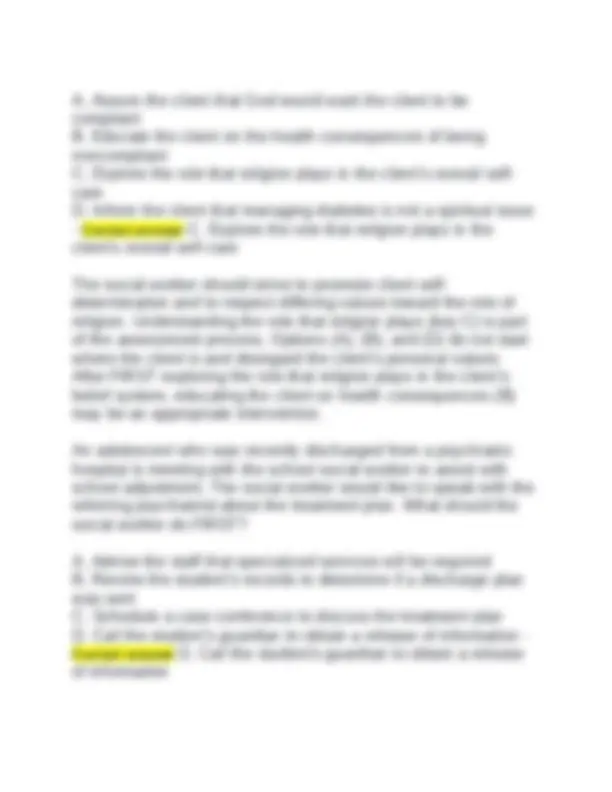
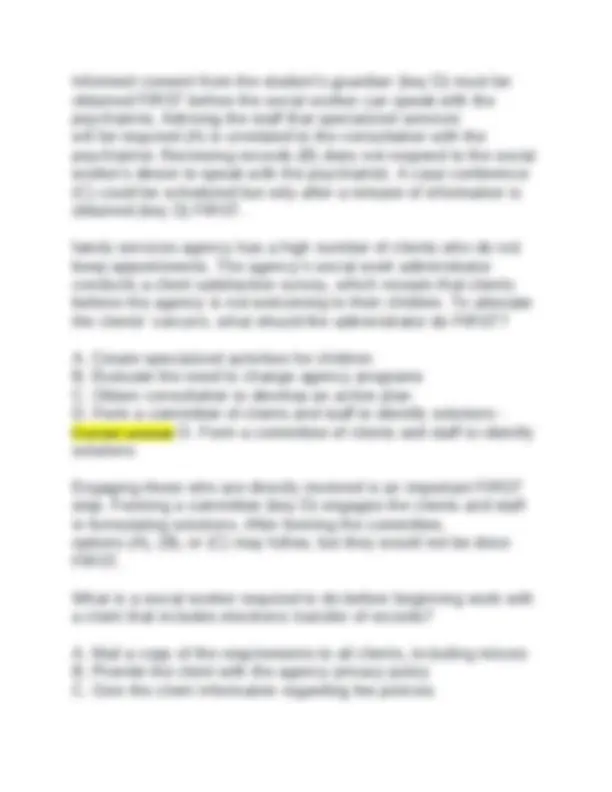
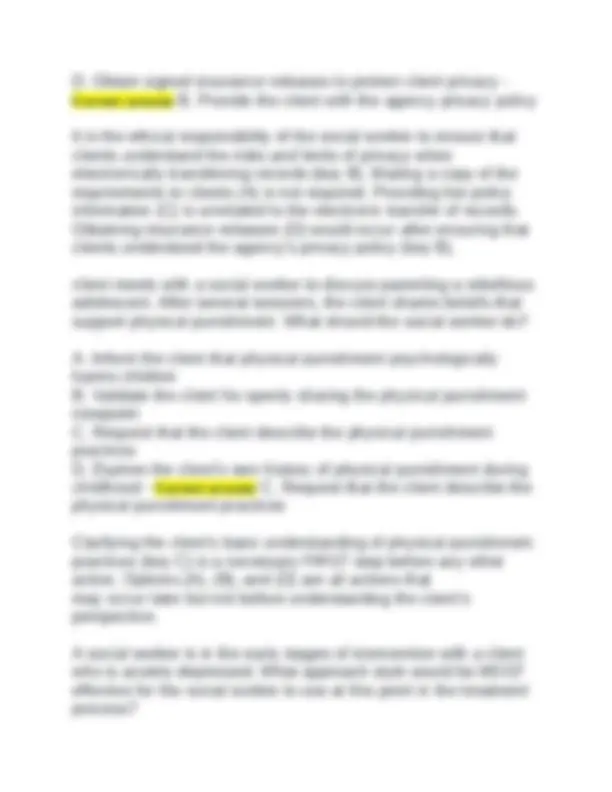


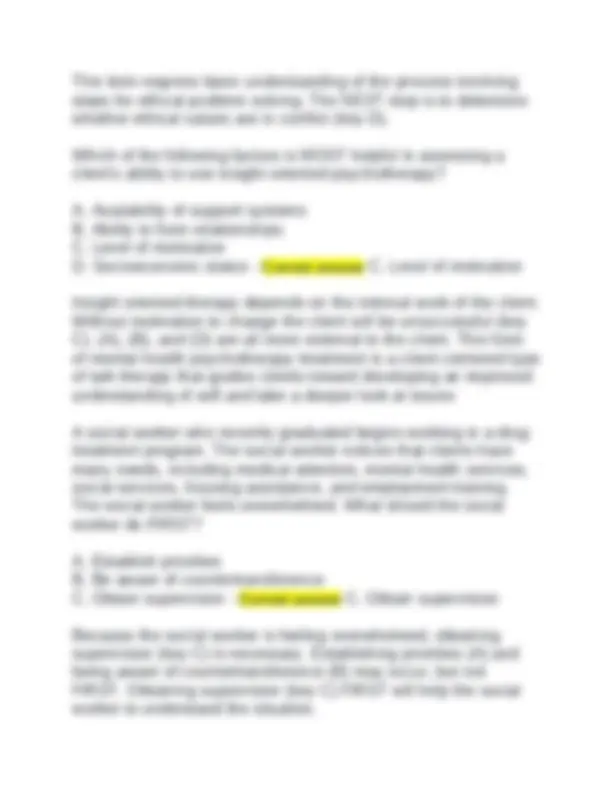
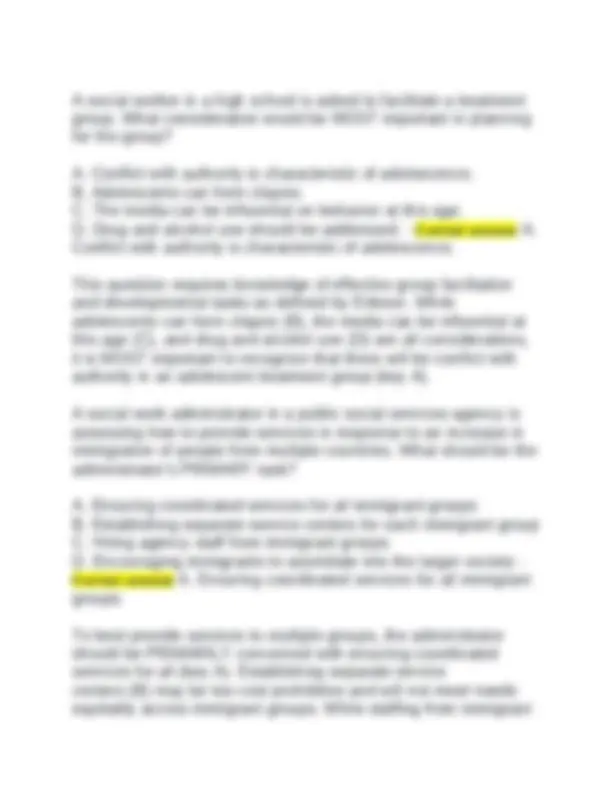
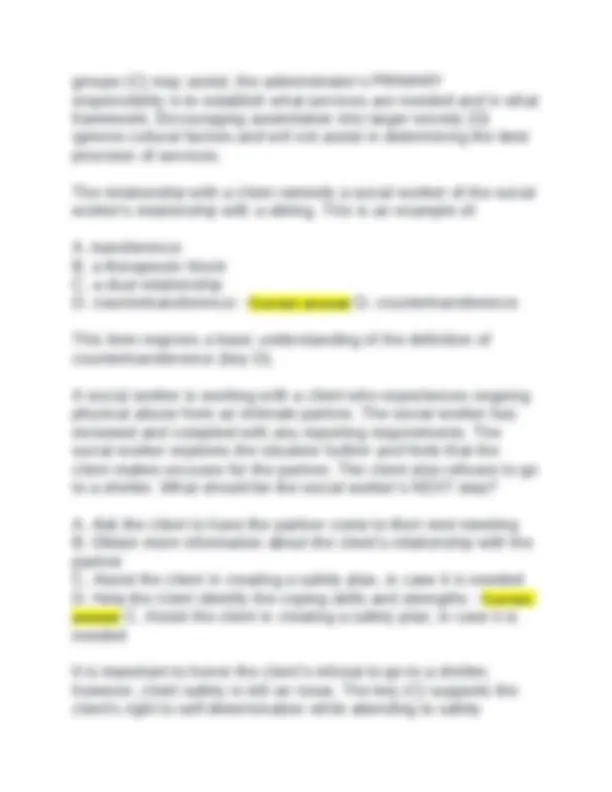
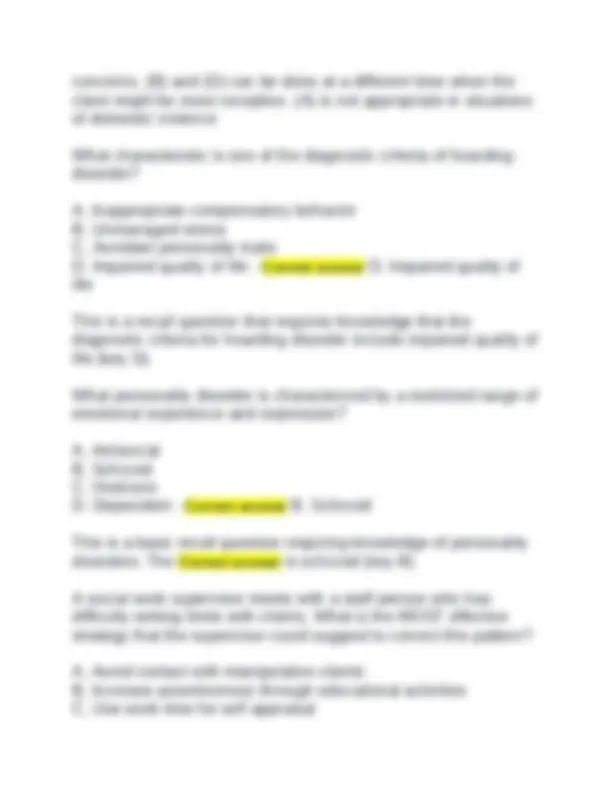
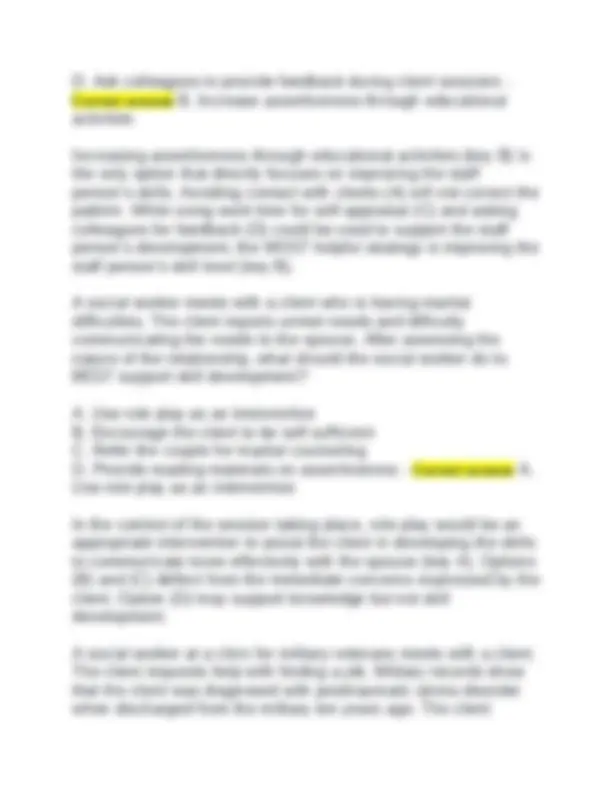
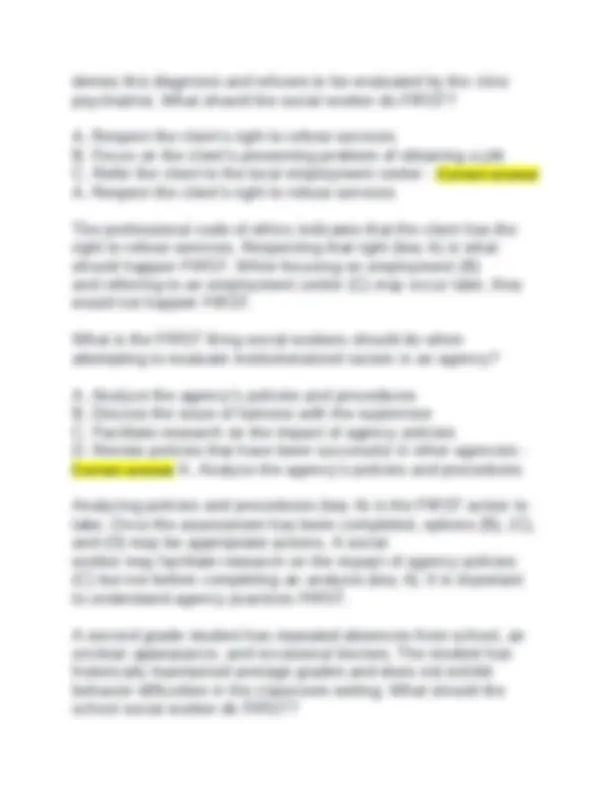
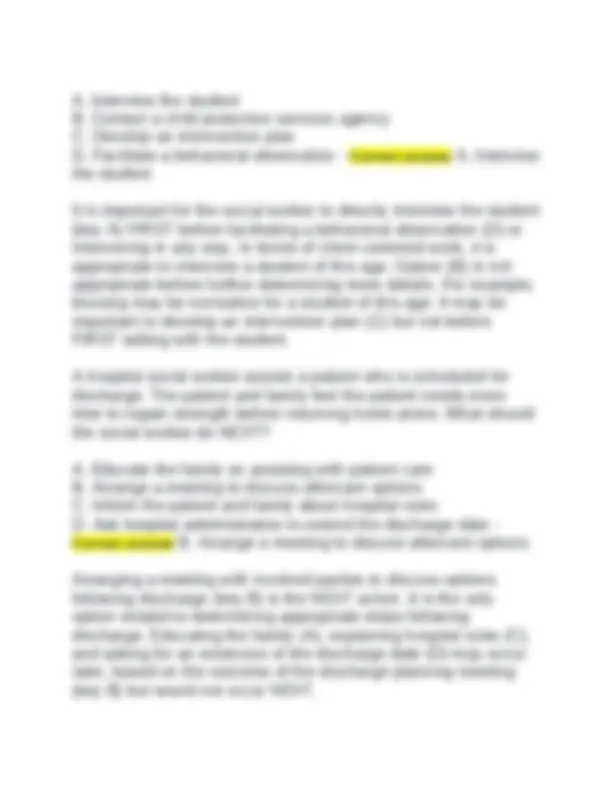
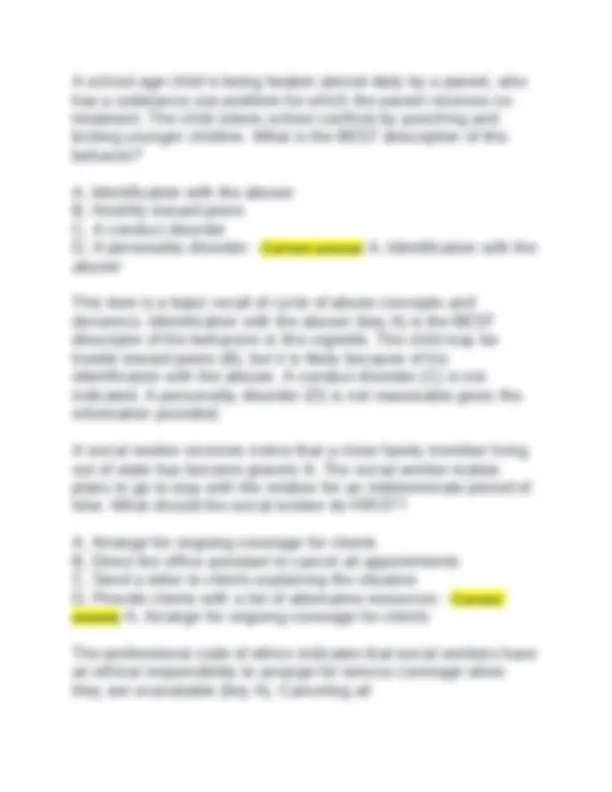
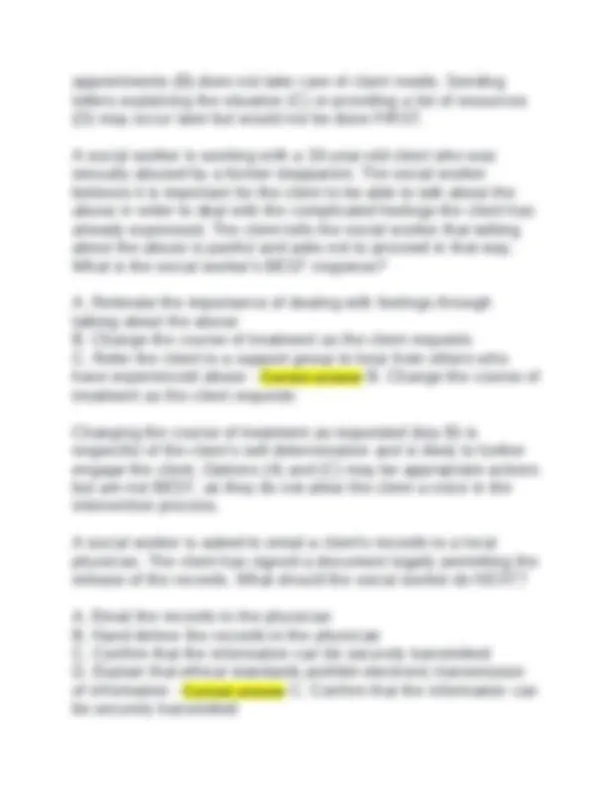
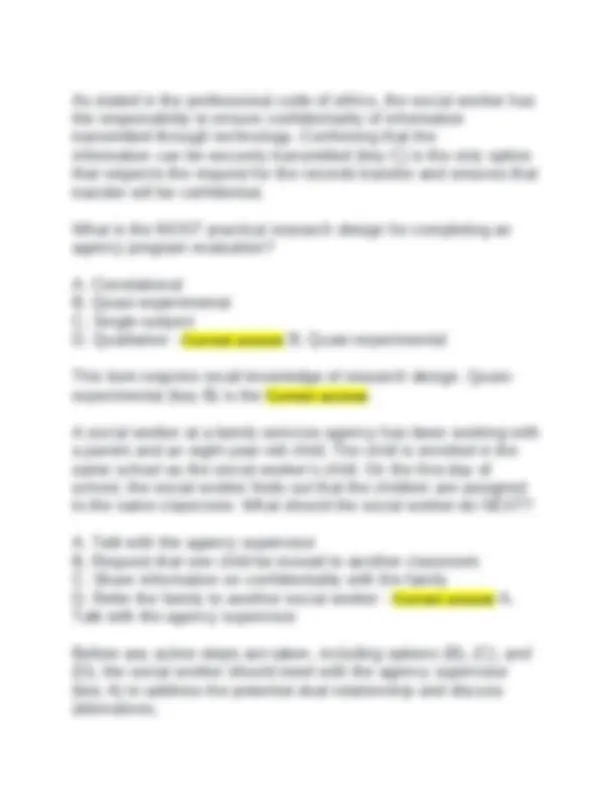
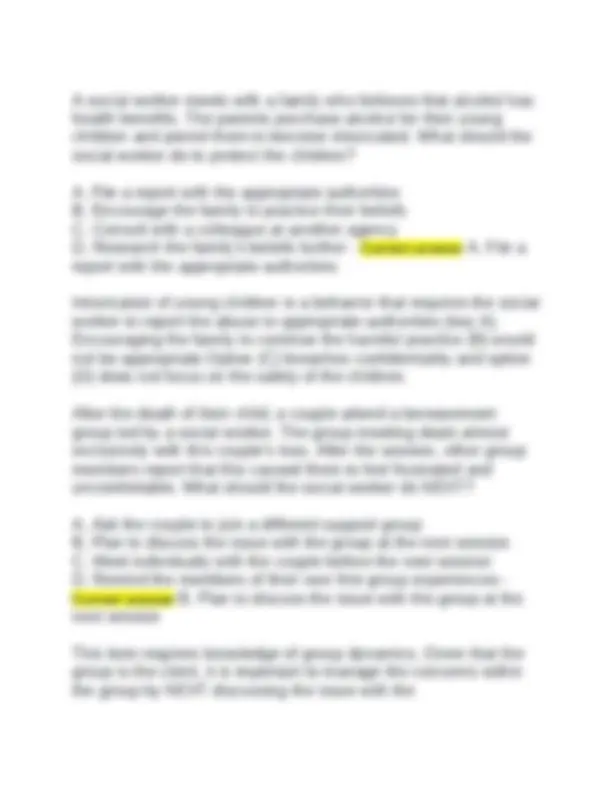
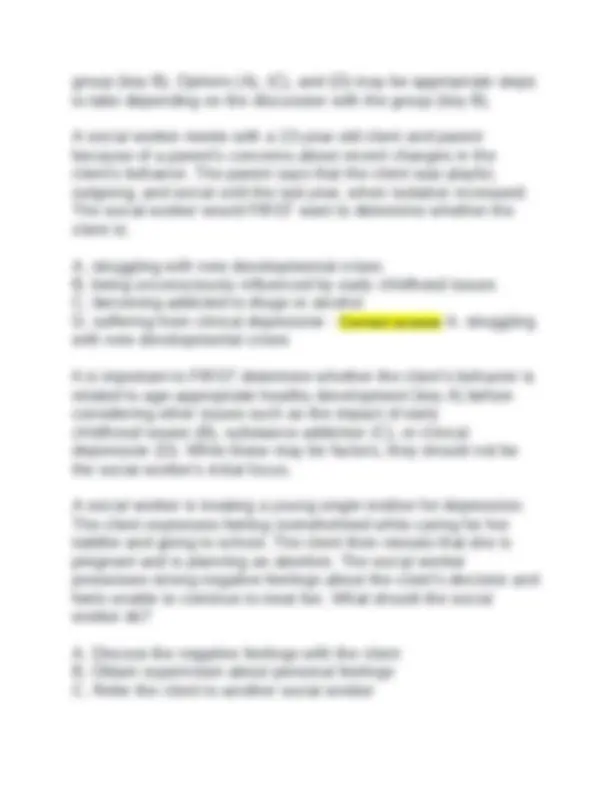
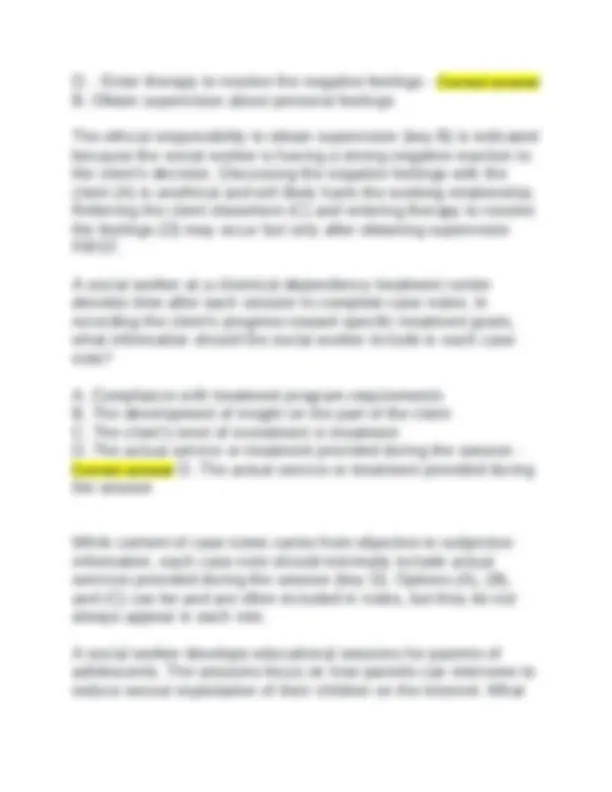
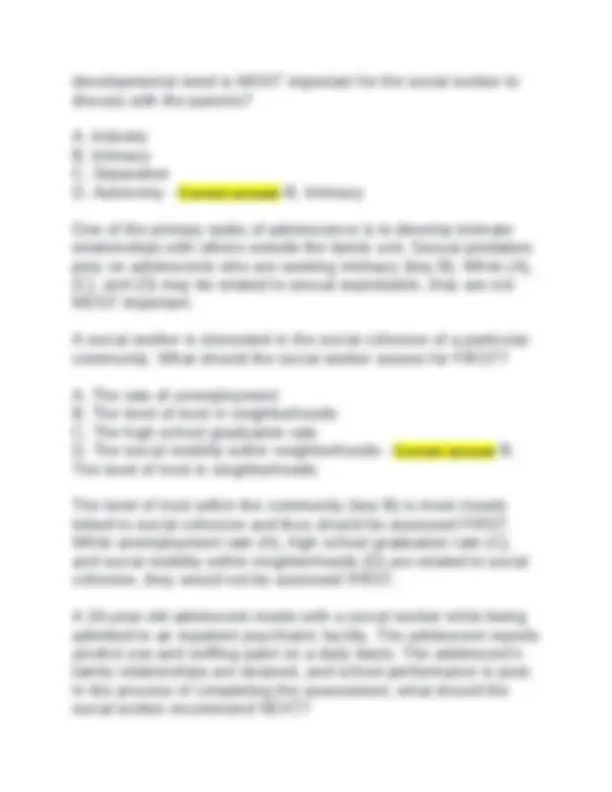
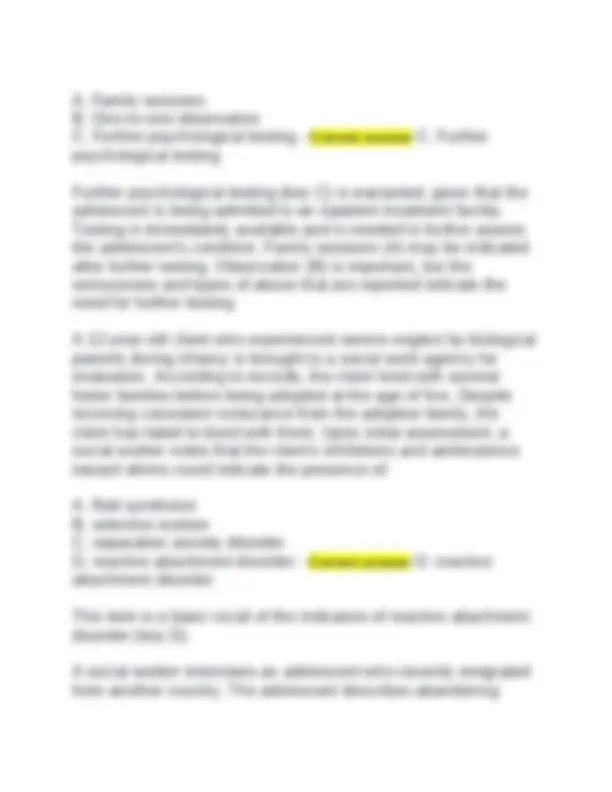
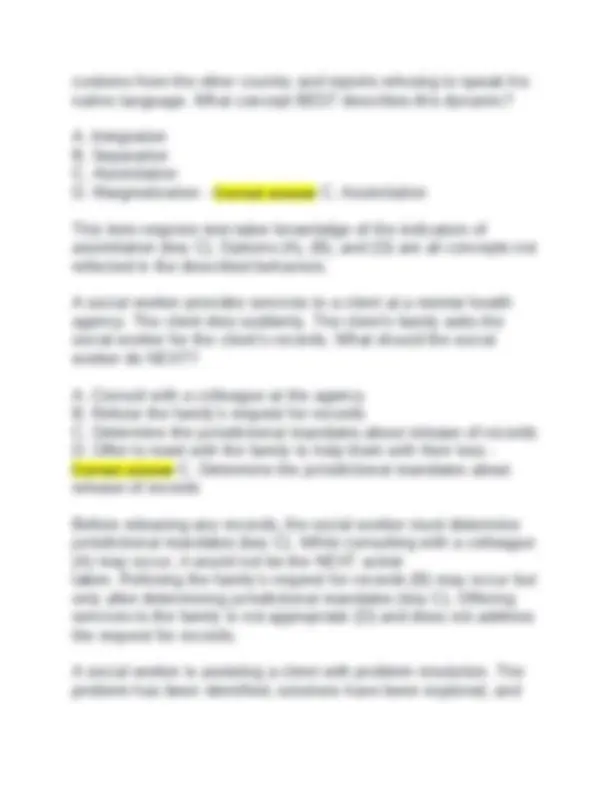
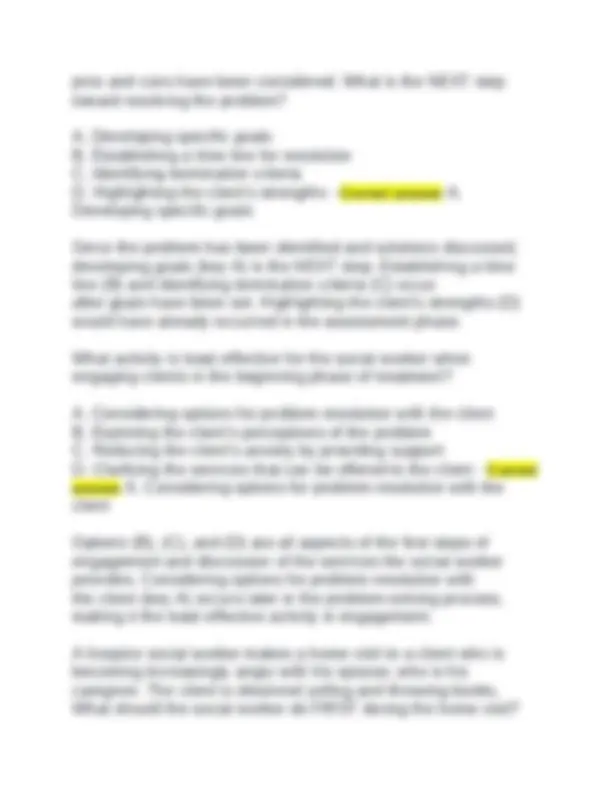
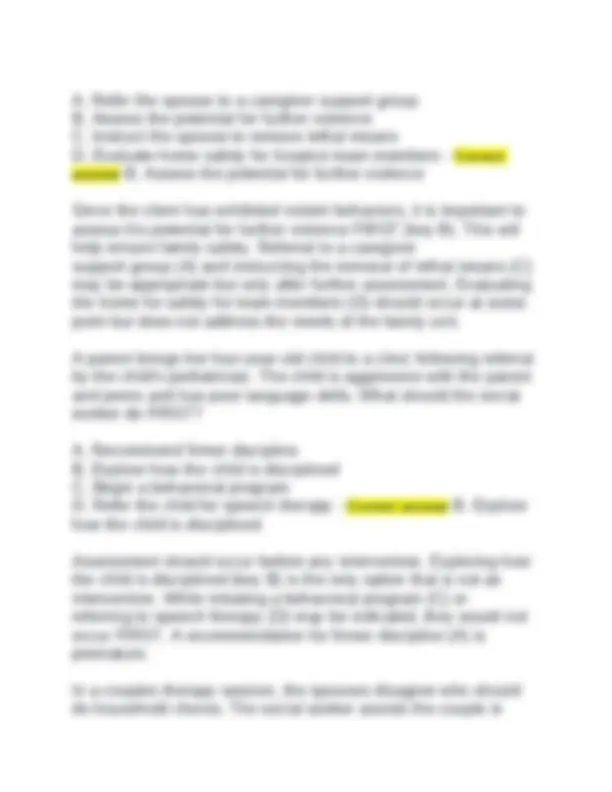
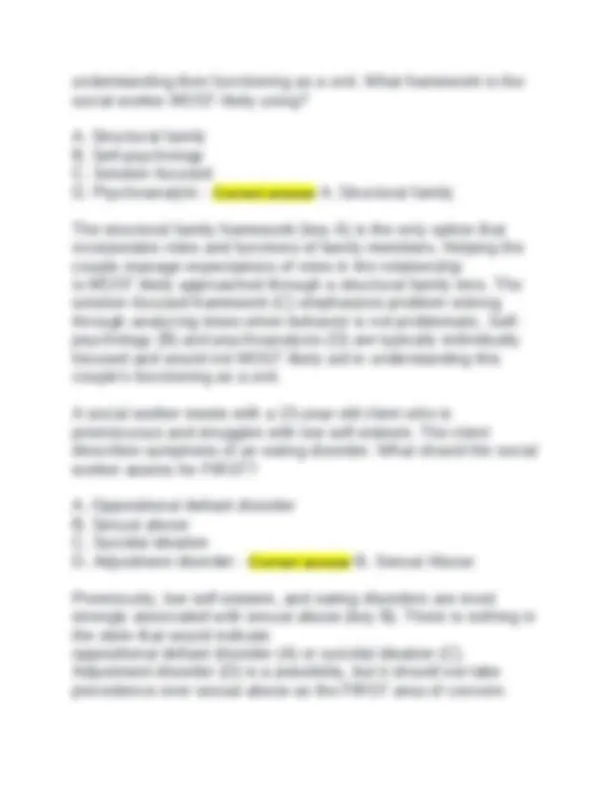
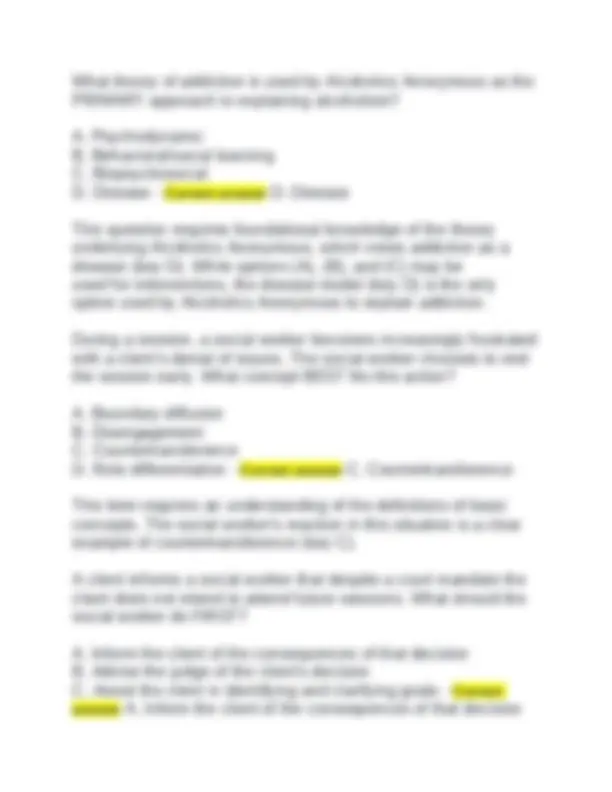
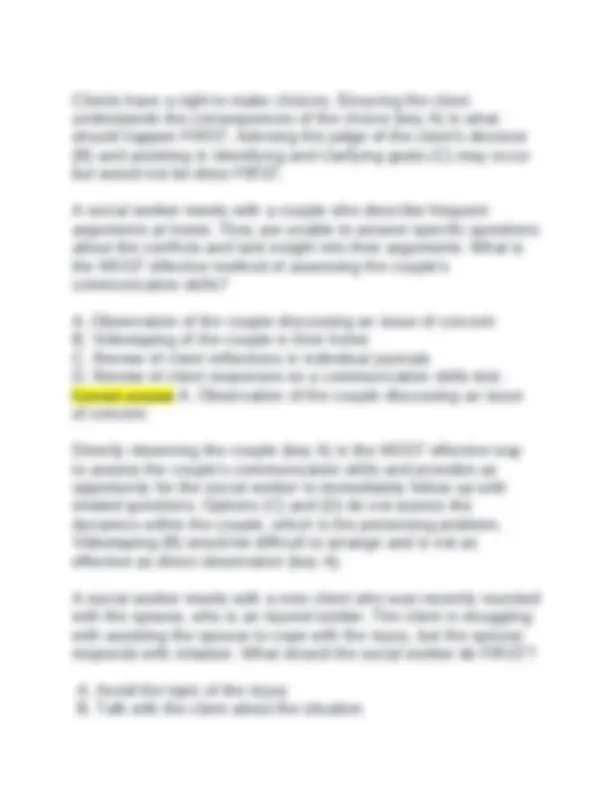
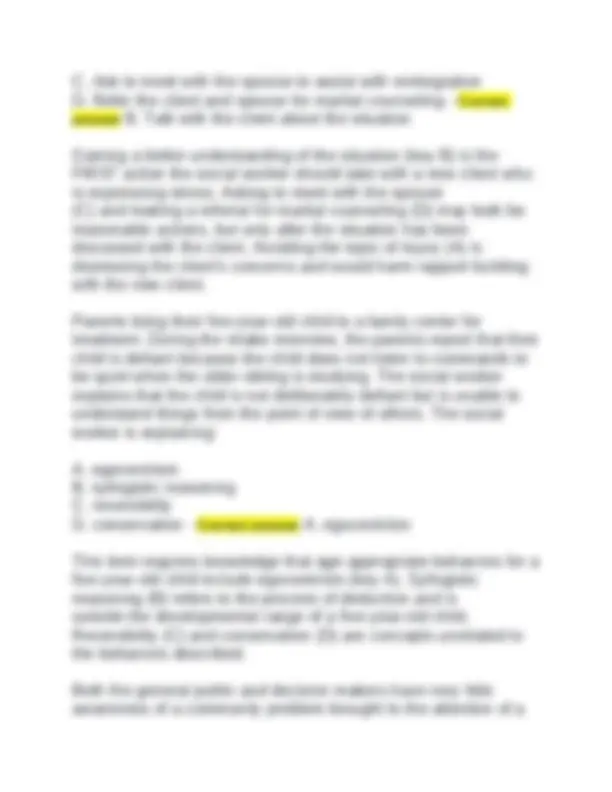
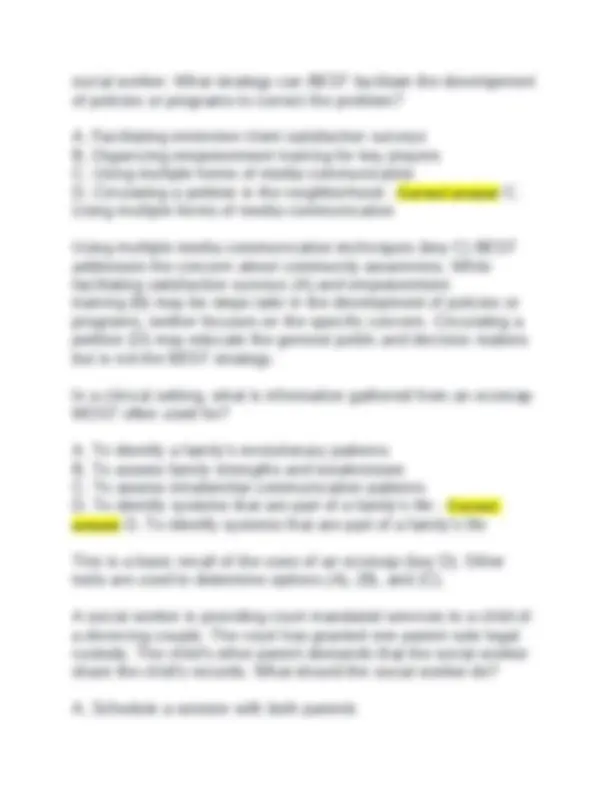
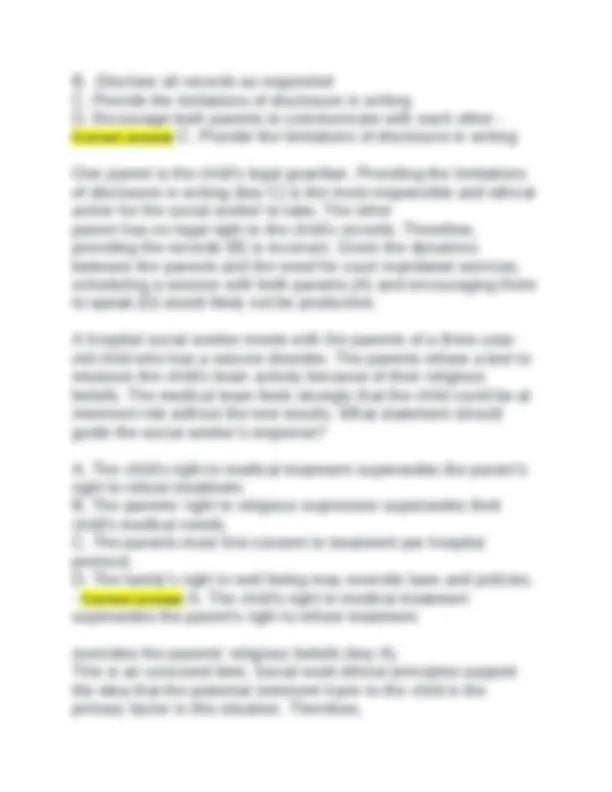
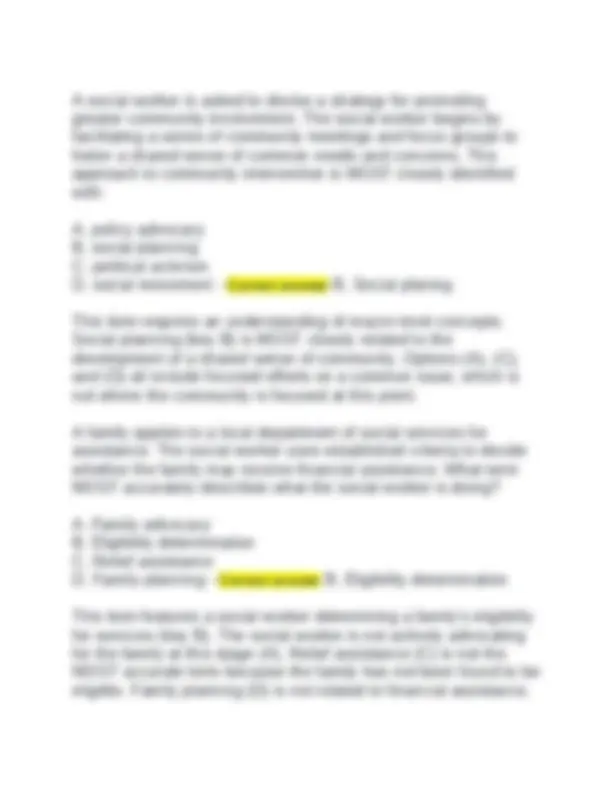
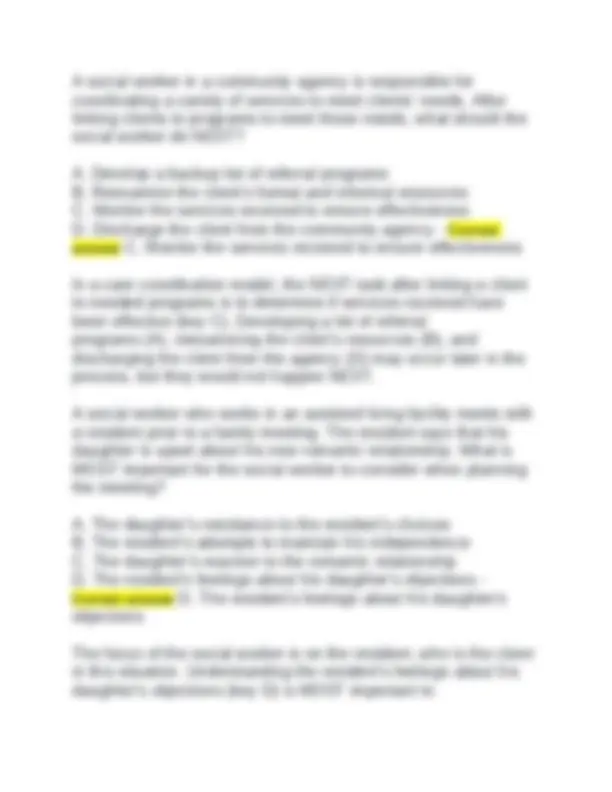
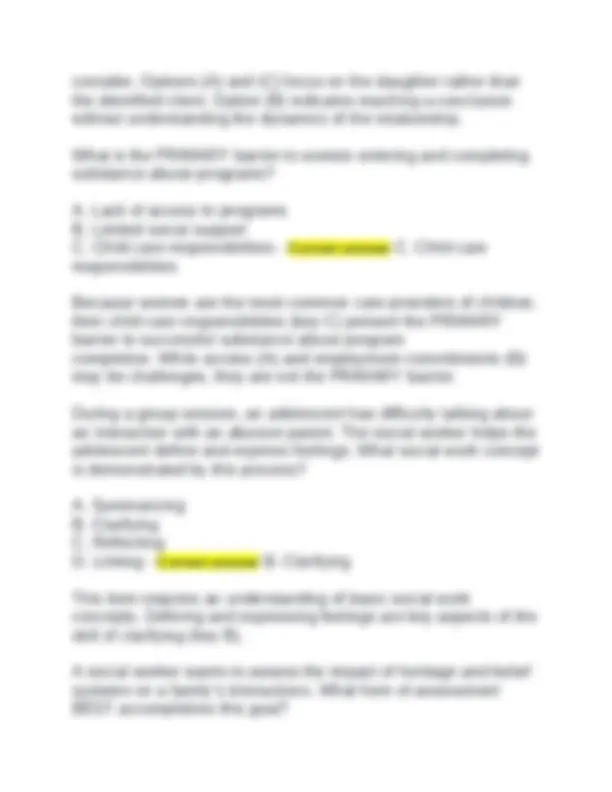
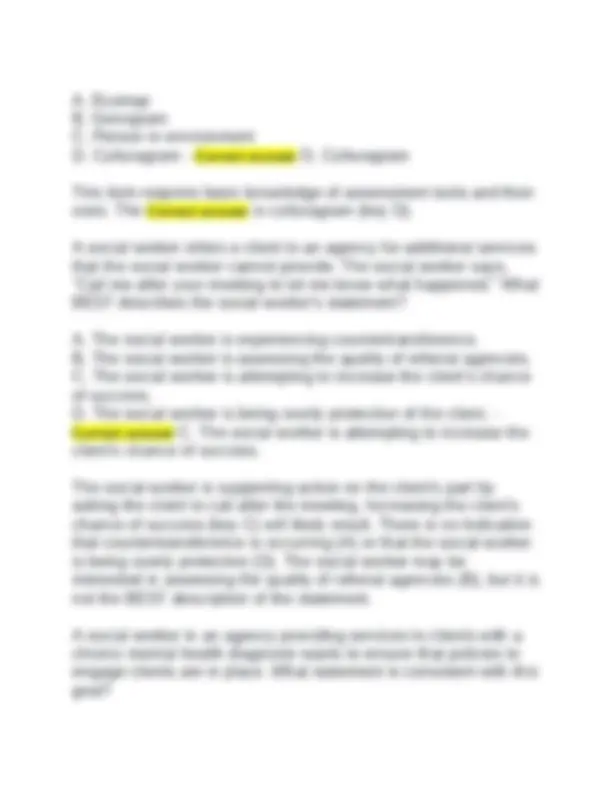
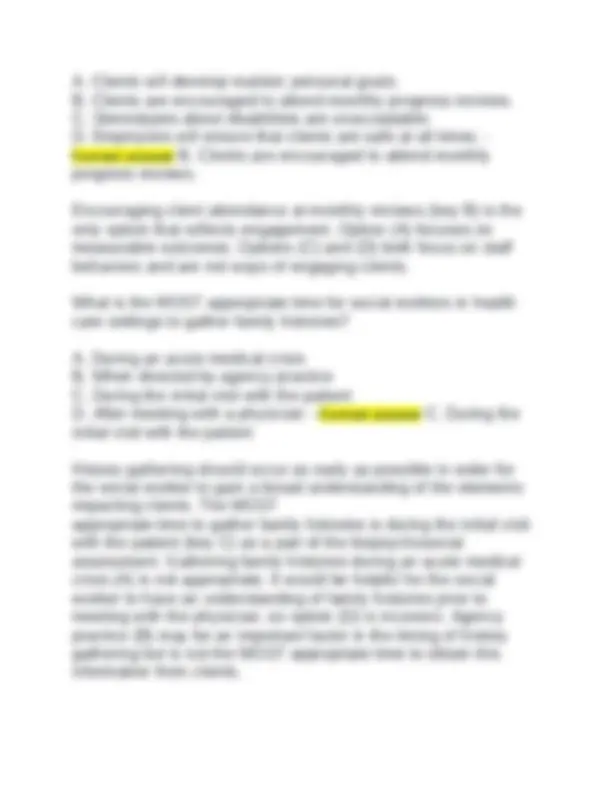
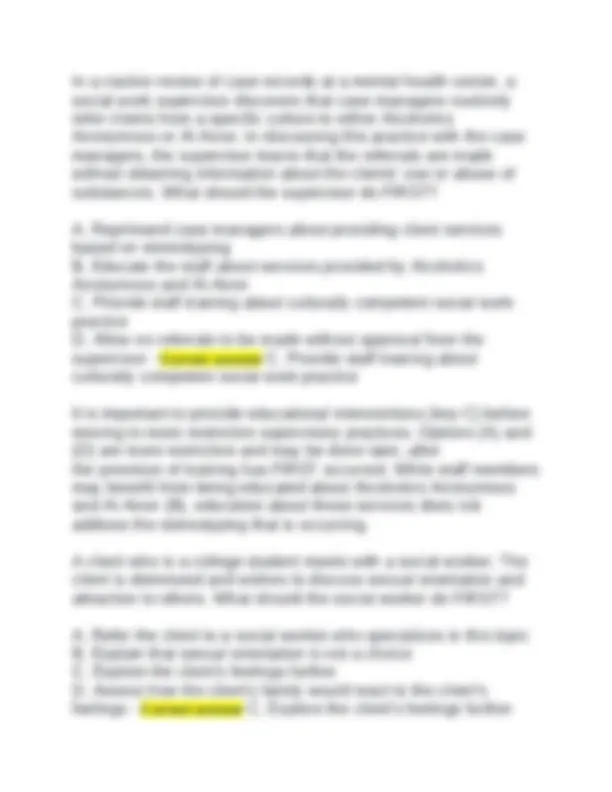
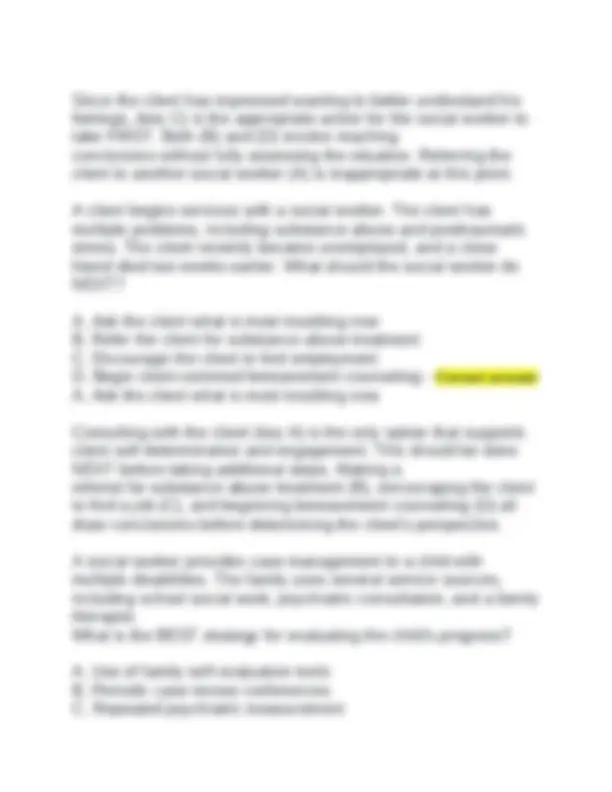
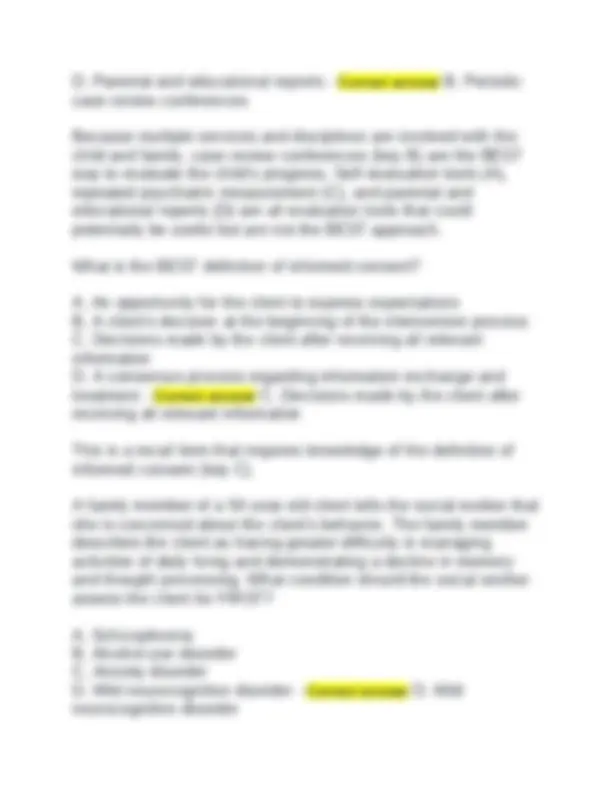
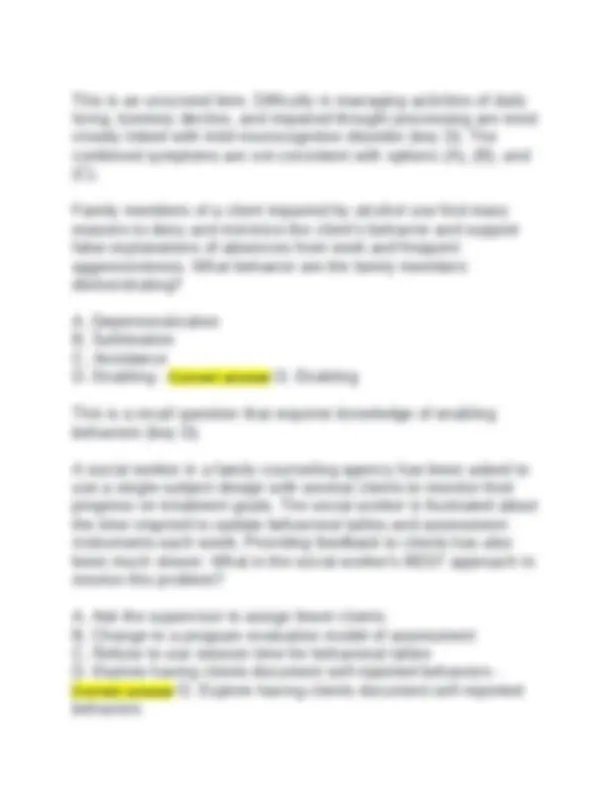
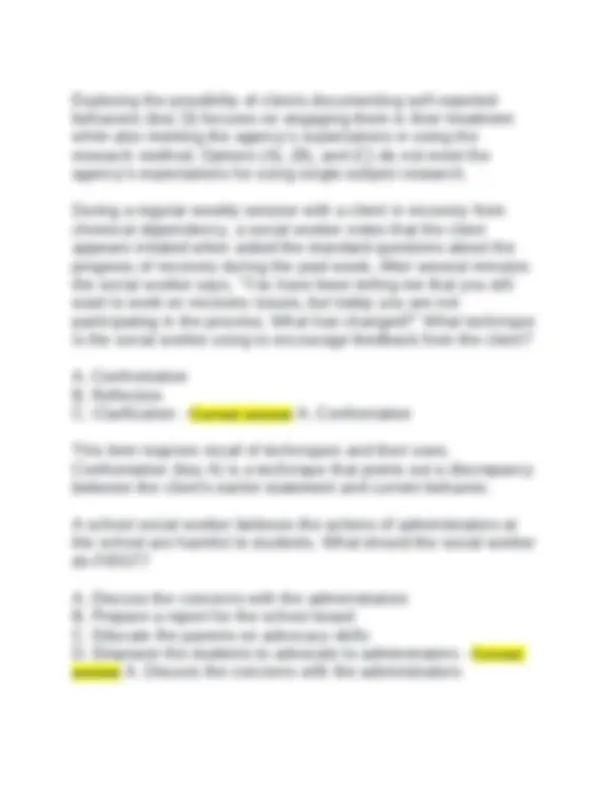
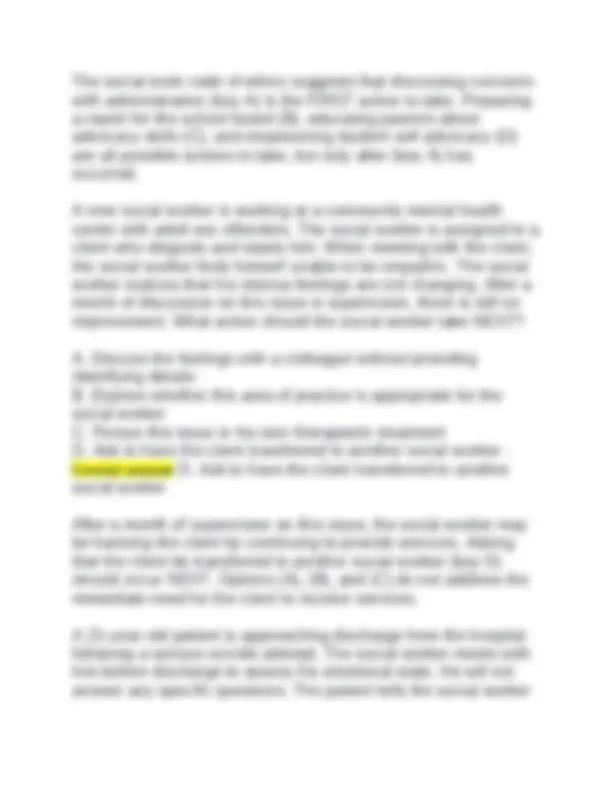
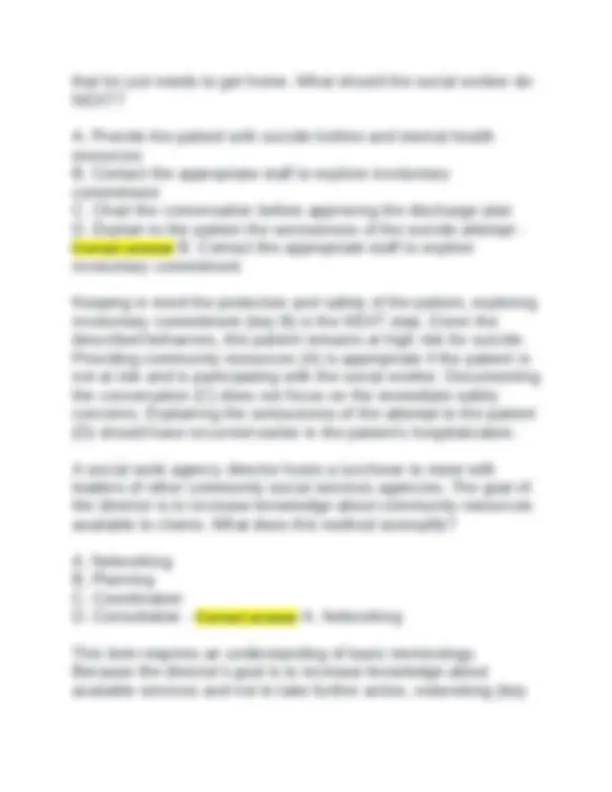
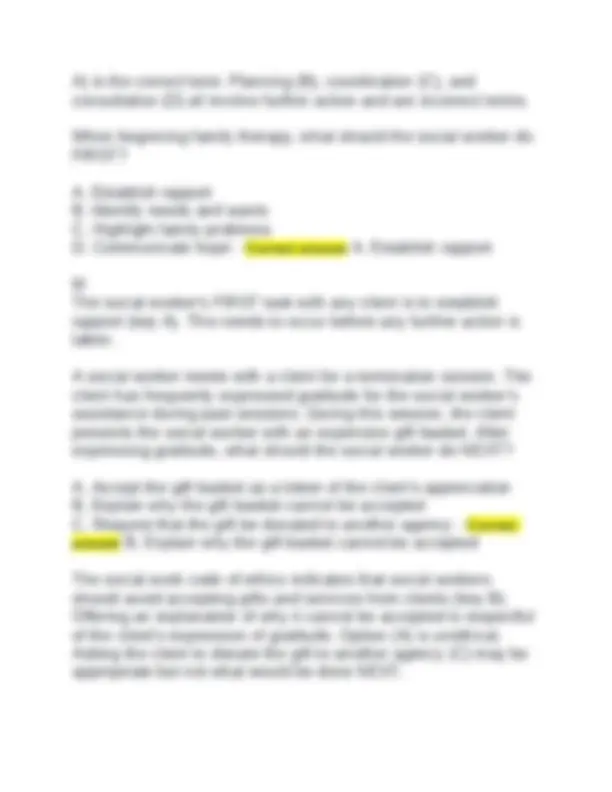
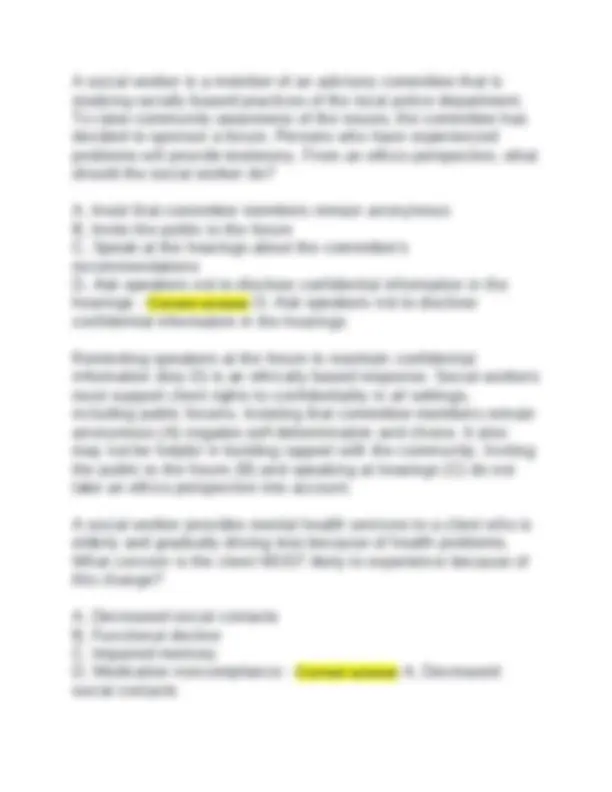
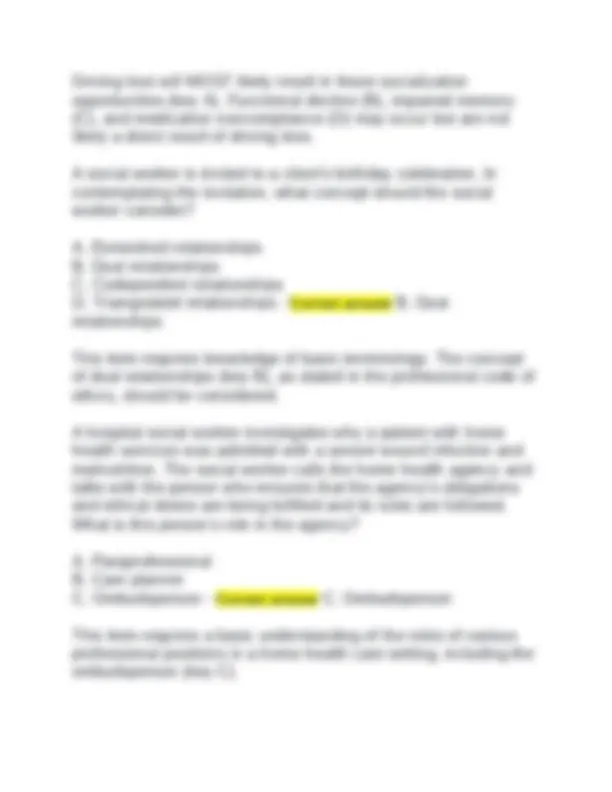
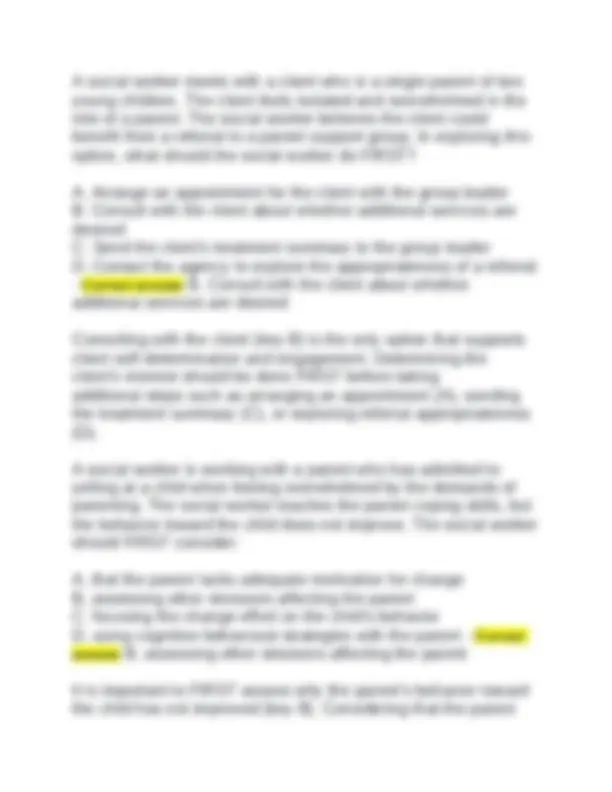
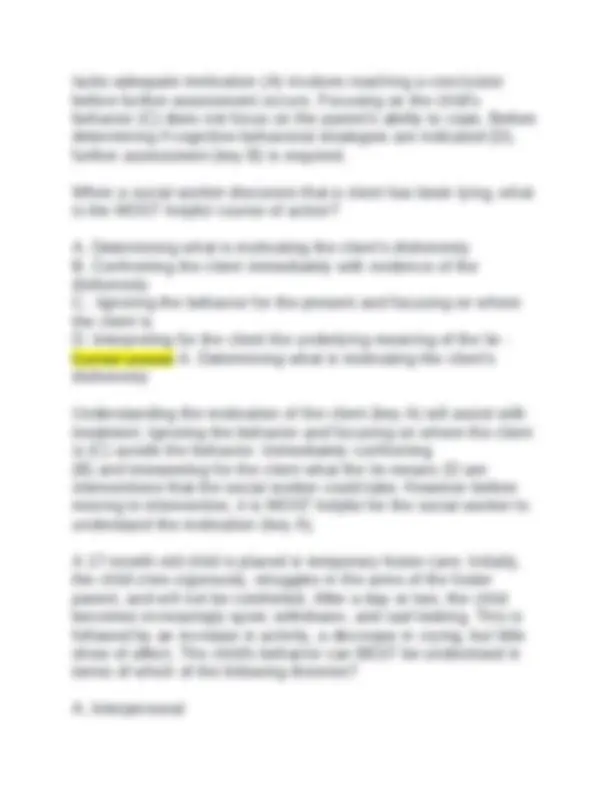



Study with the several resources on Docsity

Earn points by helping other students or get them with a premium plan


Prepare for your exams
Study with the several resources on Docsity

Earn points to download
Earn points by helping other students or get them with a premium plan
Community
Ask the community for help and clear up your study doubts
Discover the best universities in your country according to Docsity users
Free resources
Download our free guides on studying techniques, anxiety management strategies, and thesis advice from Docsity tutors
ASWB LMSW Practice Exam Questions and Answers.ASWB LMSW Practice Exam Questions and Answers.
Typology: Exams
1 / 88

This page cannot be seen from the preview
Don't miss anything!

















































































A social worker employed by a retirement home is approached by a client for help in establishing a recycling program in the facility. The social worker decides to cohost a meeting with the client to discuss the idea with other residents. What is the MOST likely reason for this approach? A. Antagonizing administration could be dangerous. B. Legitimizing the residents' concerns may be helpful. C. Helping residents start new relationships is important. D. Sharing leadership is very effective with groups. - Correct answer D. Legitimizing the residents' concerns may be helpful. By sharing leadership with the resident (key D), the social worker is supporting the resident's skill development as well as promoting positive group dynamics. Options (A) and (B) draw conclusions without substantiated information. While the potential for beginning new relationships (C) exists, it is not the MOST likely reason for the co-facilitation. At what age is separation anxiety MOST likely to occur? A. 24 months B. 12 months C. 3 months - Correct answer B. 12 months This item requires basic recall that separation anxiety is most typical around the age of 12 months (key B). A nine-month-old child is neglected and lacks a secure attachment to a caretaker. What long-term effect should the social worker be MOST concerned about as the child gets older?
A. Posttraumatic stress disorder B. Social anxiety in middle age C. High bleed pressure D. Negative social interactions with peers - Correct answer D. Negative social interactions with peers The MOST strongly linked long-term effect of insecure attachment is future negative social interactions with peers (key D). Posttraumatic stress disorder (B) is a short-term effect, while high blood pressure (C) and later social anxiety (D) are not directly linked to attachment difficulties. A 13-year-old adolescent meets with a social worker because of poor hygiene, sleeping in class, and stealing food from the cafeteria. What should the social worker assess for FIRST? A. A conduct disorder B. Child neglect C. Substance abuse D. Adolescent rebellion - Correct answer B. Child Neglect The social worker should understand that the behaviors are indicators of neglect. The social worker should assess if the adolescent's basic needs are being met FIRST. A school social worker meets with parents of a child who has recently completed treatment for cancer. The child's physician is recommending that the child return to school as soon as possible, but the parents believe that more time at home would be beneficial. What should the social worker do NEXT? A. Advocate for the parents to keep the child at home B. Explore the reasons for the parents' beliefs C. Obtain the child's perspective on the situation
A. Offer substance abuse treatment options to the client B. Refer the case for possible criminal prosecution C. Inform the client that the drug use will be reported to child protective services D. Ask the client's health care provider to drug test the client - Correct answer A. Offer substance abuse treatment options to the client Offering treatment options (key A) to the client supports client self-determination and choice. Options (B), (C), and (D) are all restrictive and breach client confidentiality. A social worker is asked to analyze new social welfare policies that will affect the community. What should the social worker do FIRST? A. Examine the likely impact of the policies on the community B. Research the historical problems that led to the policies C. Organize a grassreets coalition to diseuss reaction to the policies D. Look into legal precedents that could potentially nullify the policies - Correct answer B. Research the historical problems that led to the policies This item requires understanding of the basic steps in policy analysis. The social worker must FIRST understand the historical background of the policy (key B) before moving to the analysis stage. Options (A), (C), and (D) are steps to take later in the process. A client meets with a social worker at a crisis center. The client is living with a sibling and shares that the sibling's boyfriend is threatening to force the client out of the home. The client does not feel safe. What should the social worker do FIRST?
A. Call the police for the client B. Develop a safety plan C. Try to locate housing for the client D. Determine the nature of the danger - Correct answer D. Determine the nature of the danger Before taking any action, the social worker should assess the situation FIRST (key D). Options (A), (B), and (C) are all action steps that may be done later. Taking action without assessing the situation involves reaching conclusions without knowing the facts. A social worker meets with a new client who is diagnosed with depression. The social worker observes that the client is ambivalent, non-trusting, and passive. What should the social worker do NEXT? A. Focus on directly engaging the client B. Suggest a task to improve the client's mood C. Encourage the elient to recall better times D. Provide information about depression - Correct answer A. Focus on directly engaging the client Engaging the client (key A) is the only option that helps build rapport and supports client self-determination. This should be done before taking additional steps such as suggesting a task to improve mood (B), encouraging recall of better times (C), and educating about depression (D). © Help Diagnostic An adolescent who has diabetes is admitted to the hospital for the second time in three weeks after significant changes to the client's insulin levels. The physician believes that the adolescent
A. Obtain a detailed social history on the client B. Probe for a substance abuse problem C. Ask the client to obtain medical consultation - Correct answer C. Ask the client to obtain medical consultation The described physical symptoms suggest a potential medical issue, which indicates the FIRST action is to obtain medical consultation (key C). Obtaining a social history (A) and assessing for a substance abuse problem (B) may also be done later. It is important to FIRST rule out medical issues A client who is depressed mentions plans for suicide to a social worker. Privacy and confidentiality had been discussed early in the treatment process. The social worker believes that the threat is serious. What should the social worker do NEXT? A. Respect the client's right to confidentiality B. Consult with an agency supervisor C. Develop a safety contract with the client D. Discuss the need for hospitalization with the client - Correct answer D. Discuss the need for hospitalization with the client Discussing the need for hospitalization (key D) is the NEXT step after the social worker has determined the existence of a serious threat. Consulting with a supervisor (B) would be appropriate but only after first discussing the plan for hospitalization with the client (key D). Rights to confidentiality (A) are superseded by the seriousness of the threat. A safety contract (C) is not known to be an effective intervention for suicide prevention when a client has developed a plan. During a therapy session, a client reveals to the social worker that she has difficulty managing her three-year-old child. The client reports that her child ran into traffic and was nearly hit by a car.
What should the social worker do FIRST? A. Report the possible neglect to child protective services B. Work with the client to develop a safety plan C. Consult with the social work supervisor D. Refer the client to a parenting class - Correct answer B. Work with the client to develop a safety plan Developing a safety plan (key B) is the FIRST action that a social worker would take upon learning of the client's concerns. While the social worker might consult with a supervisor (C) and refer the client to a parenting class (D), these would occur only after attending to the client's immediate issues. There is no evidence of child abuse or neglect (A). Parents of a 24-month-old child report their only concern is that their child plays alongside of, but not with, other children. What should the social worker do? A. Assess for symptoms of developmental delays B. Observe the child's play in a group setting C. Reassure the parents that parallel play is typical at this age - Correct answer C. Reassure the parents that parallel play is typical at this age The role of the social worker is to educate the child's parents about typical developmental behavior (key C). This question requires a basic knowledge of parallel play. A social worker is providing marital therapy to a couple. What goal statement is MOST likely to enhance a couple's motivation? A. Increase by one-fourth the frequency of positive statements B. Reduce by one-third the angry exchanges C. Eliminate all physical altercations
A. Make corrections as needed B. Claim record confidentiality C. Send the records D. Meet with a supervisor - Correct answer D. Meet with a supervisor When a court order is received to disclose client records, supervision should be obtained FIRST (key D). Depending on the circumstances, the records may need to be sent (C) or a claim for confidentiality may need to be made (B). Making alterations or corrections to the record (A) should not be done A weekly meeting is held at a family services agency to determine if referred families meet the criteria for services. Staff members are frustrated because the meetings have become characterized by unrelated discussion and have begun to last several hours. What should the social worker do to faciliate the meeting? A. Limit the number of cases presented B. Redirect staff members who do not stay on topic C. Schedule individual meetings with problem staff members D. Set time limits for the meeting - Correct answer B. Redirect staff members who do not stay on topic One of the key roles of a group facilitator is to keep participants focused on the purpose of the meeting. Since staff members are discussing unrelated matters in the meeting, providing redirection is critical (key B). While limiting the number of cases presented (A), scheduling individual meetings (C), and setting meeting time limits (D) may be appropriate interventions, they are not the most helpful options for the social worker to take in order to ensure that the meetings run smoothly and efficiently.
A medical social worker in a home health setting believes a client is abusing alcohol. The nurse reports that the client is not progressing medically. During a home visit, the social worker notices multiple empty liquor bottles in the trash. What should the social worker do FIRST? A. Explore this observation with the client B. Refer the client to chemical dependency treatment C. Assess the client for acute alcohol poisoning D. Request that the nurse make an additional visit - Correct answer A. Explore this observation with the client Before concluding that alcohol poisoning is occurring (C), intervening with a treatment referral (B) or making a referral to a team member (D), the social worker should discuss the observation with the client (key A). This is the FIRST step in engaging the client and learning more about the situation. A client is referred to a domestic violence shelter after experiencing abuse by a partner. The client tells the social worker of plans to return to the abusive partner because the client believes returning is God's will. What concept BEST explains the client's reasoning? A. Fatalism B. Nihilism C. Familism D. Paternalism - Correct answer A. Fatalism This question requires the test-taker to recognize demonstrations of fatalistic thought (key A): a belief that all events are predetermined and therefore What task is the FIRST step in setting up a program evaluation?
B. Advise the client that agency policy prohibits client access to records C. Allow total access to records pertaining to the client and the spouse D. Request a ruling from the agency's executive director and attorney - Correct answer A. Allow the client access to information pertaining only to the client Due to client confidentiality, only information pertaining directly to the client (key A) may be shared. Option (B) is unethical because records should be shared if reasonable. Allowing total access to all records (C) disregards the confidentiality of the spouse and is also unethical. Option (D) negates the social worker's responsibility to provide reasonable access to records and is not the MOST appropriate response. What instrument is MOST likely to be used by social workers in the initial assessment of families? A. Ecomap B. Life history grid C. Family sculpting D. Global Assessment of Functioning Scale - Correct answer A. Ecomap This item requires knowledge of assessment tools and how they are used. A hospital social worker works with a terminally ill patient who is refusing the use of a breathing machine to prolong life. What action is the patient choosing? A. Active euthanasia B. Natural death C. Palliative care - Correct answer B. Natural death
This item requires a basic understanding of medical terms related to end of life care. The personality disorder in which the individual is hypersensitive to potential rejection, has low self-esteem, is socially withdrawn, and is generally unwilling to enter social relationships is: A. avoidant B. schizoid C. antisocial D. histrionic - Correct answer A. Avoidant This recall item requires basic knowledge of the features of personality disorders. What term describes the belief that one's thoughts alone can result in the accomplishment of certain wishes? A. Depersonalization B. Magical thinking C. Thought broadcasting D. Looseness of associations - Correct answer B. Magical Thinking This is a basic recall item requiring test-taker knowledge of commonly used terms related to cognition. An adolescent who has been living with her 23-year-old boyfriend for six months calls a crisis hotline at 2:00 a.m. requesting help. She says her boyfriend evicted her because she may be pregnant. She will be 18 in two days. The adolescent says that she has no place to go. What should the social worker do FIRST?
the person. Referring clients to a human rights agency (A) would occur only after a potential human rights violation is identified. It is unrealistic to require empathy (C). Discouraging clients from pursuing employment until treatment is completed (D) does not promote self-determination and is not a supportive, strengths based approach. A client reacts to criticism with rage, is interpersonally explosive, has a grandiose sense of self, is preoccupied with thoughts of unlimited success, and has a sense of entitlement. This meets the criteria for which of the following DSM personality disorder diagnoses? A. Paranoid B. Antisocial C. Narcissistic D. Histrionic - Correct answer C. Narcissistic This item requires a test-taker to differentiate between the indicators of different personality disorders and determine that the indicators in the item are associated with key (C). Due to the recent death of a parent, a hospital social worker is experiencing difficulty concentrating and completing work-related tasks. A colleague reports to the social worker that patients are complaining about the social worker's irritability. The social worker should: A. schedule personal leave B. self-monitor reaction to patients C. appropriately disclose the loss to patients D. seek consultation with the supervisor - Correct answer D. seek consultation with the supervisor
If a social worker's personal life is interfering with work it would be appropriate to seek consultation with the supervisor (key D). Consultation should be sought first before a plan for personal leave (A) is determined to be necessary. Self-monitoring (B) is not appropriate as the social worker may not be able to identify personal behaviors that impact care due to grief. Self- disclosure (C) would not be appropriate as it should only be used when it will benefit the client. What condition is NOT a cause of mild or major neurocognitive disorder? A. Alzheimer's disease B. Cerebral vascular event C. Osteoporosis - Correct answer C. Osteoporosis This item requires knowledge that osteoporosis (key C) is not directly linked to mild or major neurocognitive disorders. Options (A) and (B) are each correlated with neurocognitive disorders. During an assessment, a social worker is trying to understand a client's perspective. At the same time, the social worker is maintaining the perspective of an outside observer. What concept is BEST reflected? A. Sympathy B. Supportive treatment C. Empathy D. Differential validation - Correct answer C. Empathy This item requires an understanding of the concept of empathy (key C): attempting to understand the client from his or her perspective while maintaining objectivity.
clients (D) would assist the clients with life skills and could increase self-efficacy, which is the goal of the life skills class. What is the MOST likely reason that a client in an outpatient alcohol treatment program would be prescribed the drug naltrexone in conjunction with counseling? A. To treat clinical depression B. To ease alcohol withdrawal symptoms C. To induce necessary sleep D. To decrease cravings for alcohol - Correct answer D. To decrease cravings for alcohol This item requires a basic knowledge of alcohol treatment and interventions. A social worker creates a job readiness program for young people transitioning to adulthood. The program is based on developmental theory. What is the PRIMARY goal of the program? A. Learning the basics of how to find employment B. Keeping track of the number of participants who secure employment C. Determining a particular career path at program onset D. Ensuring connections to community resources and systems - Correct answer A. Learning the basics of how to find employment Learning how to find employment (key A) is the only option focusing on the developmental task of young adulthood and is the PRIMARY goal of the program. Tracking numbers of participants (B) is an evaluation of the program, not the goal. Determining a career path (C) may be an individual task but is not a program goal. Ensuring connections to community resources
(D) may be a goal, but one that is secondary to learning how to find employment (key A). A client is in treatment with a social worker in a fee-for-service setting. After paying in full and on time for the first ten sessions, the client begins to make either partial payments or no payments at all. Assessment of risk indicates that the client poses no danger to self or others. According to ethical standards of social work practice, what is the social worker's BEST response? A. Continue services after negotiating a nonmonetary compensation system B. Suspend services until the client has caught up on all financial obligations C. Terminate services after the third incident of insufficient or nonpayment D. Terminate services if debt persists after a discussion of financial obligations - Correct answer D. Terminate services if debt persists after a discussion of financial obligations Since the client poses no danger to self or others and is in arrears, services can be terminated after the discussion of financial obligations has occurred (key D). Negotiating a nonmonetary compensation system (A) suggests bartering, which is not the BEST response. Suspending services until payment is made (B) is possible, but it is not the BEST response. Termination after a third time of nonpayment (C) uses an arbitrary number of incidents to make a decision about termination. A social worker is providing therapy to a family. The couple have been arguing constantly for several months and are considering a separation. Recently, the oldest child began acting out in school. With attention focused on the child's problems, arguments between the parents have subsided. What concept BEST describes this family's situation from a systems perspective?